A blog for my StudyUSA intercession in Hawaii studying Microbes!
Don't wanna be here? Send us removal request.
Text
Day 14
LAST DAY IN HAWAII :((
While I, and the group, was not thrilled for the last minute meetings added to the schedule on our last day. Both Symbrosia and Hatch put on great presentations. Symbrosia was interesting in particular to me as someone who’s grown up with cattle being a financial contributor to my family. I’m also someone who values the environment and combating climate change, in which cattle live stocking is a huge ecological drain between land and water consumption and methane production. Symbrosia has found a concentration of added seaweed to cattle diet that can cut methane production by 90% if used properly. Farmers can then sell carbon credits back to the government for a financial benefit too. They are a completely organic product, but I found it interesting that it’s not legal to sell in the US yet, with their main buyers being New Zealand and the EU, and trying to get consumers in Brazil. Also, shout out to the awesome sticker. Next, it was over to Hatch. Which seemed like venture capitalism but for ocean/aquaculture businesses. Their CEO was wonderful in taking time to talk to us, but I felt back for our groups lack of interaction, but the fact was even those of use interested in listening didn’t have much to give since we didn’t have interest in starting businesses, much less aquaculture businesses.
For our last afternoon in Hawaii, I decided I wanted some more sun and water. After a lunch across the street from the hotel with a guava-mule cocktail and a WONDERFUL burger, I parked myself by the pool. I had a couple of poolside cocktails, as well as another shaved ice (lilikoi and cherry, yum!). Anna, Jocelyn, and I made friend with a lovely couple from the UK who were very interested in Ole Miss and the class we were running!
At 5:30, it was sadly time to pack up and dry off so we could meet Noah in the van and head to the airport. Thankfully, my bags were still under 50 pounds which with all I gained on this trip, was nothing short of a miracle. Finally, I ate my last poke (Ahi Teriyaki) in the airport, and then boarded the plane. Aloha, Hawaii!
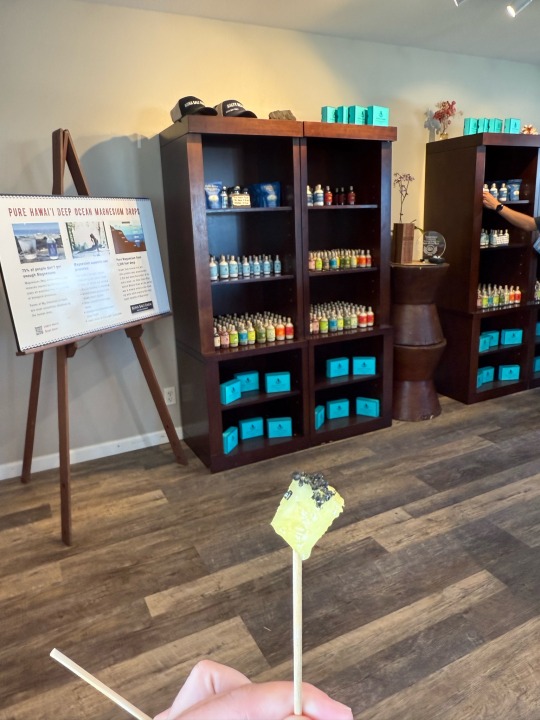
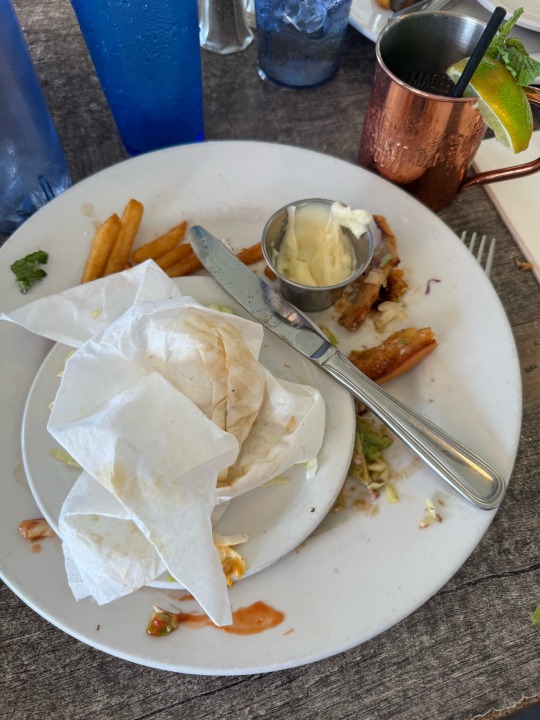
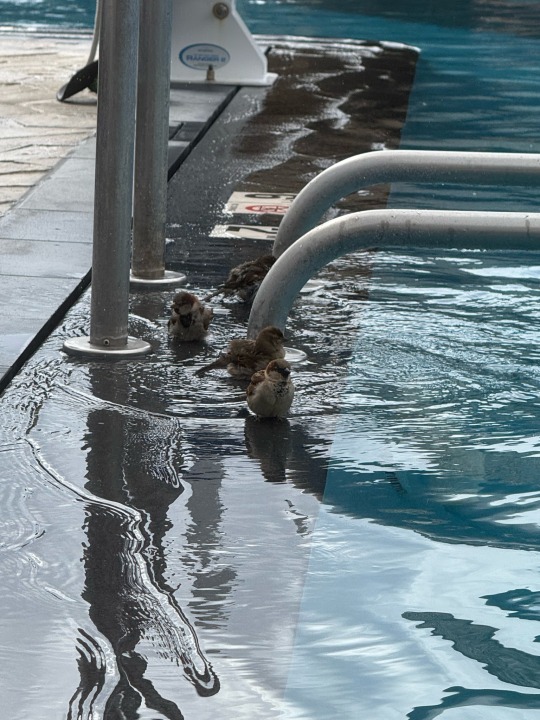

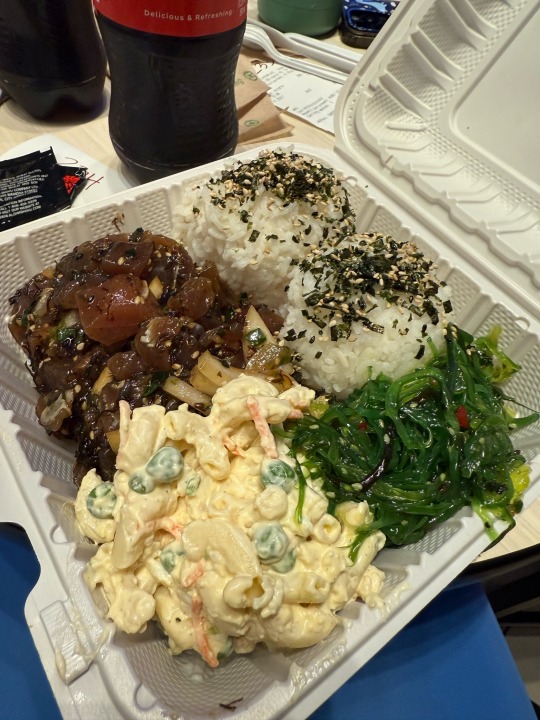
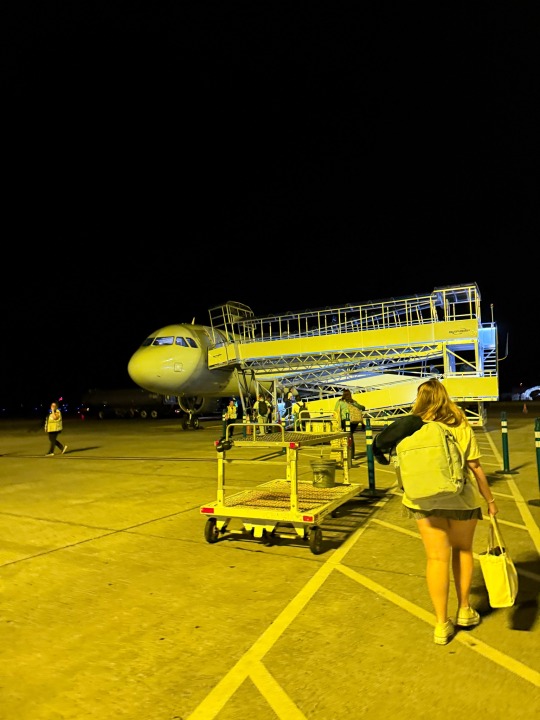
0 notes
Text
Day 13 Blog
First day in NEHLA park this morning. We first talked to one of the women in work in the main / leasing office, explaining the purpose of the science park and what kind of businesses they support. She offered snacks in return for correct answers as she explained the importance of oceanic resources, sustainable aquaculture, and renenwable power generated by the ocean. Next, it was on to see Neil. An australian who has found himself in the Hawaiian aquaculture game. He farms fish in large tanks as well as seafood. I enjoyed hearing Neil give advice on how he made it into his passion and why it was so important to him. He also let us try red seaweed and sea grapes, and I found out the stall I’d bought sea grapes from earlier this week was also a NEHLA company!
After wandering in the sun all morning, we headed for a class lunch at a chinese place where we reflected on the course with Dr. Hom. I gave my pros and cons (pro: lots of variety in course work and getting to see the entire island, con: not enough free time). While here, I planned a group outing with Jocelyn, Morgan, Anna, and Erin. We put down our credit cards and signed our liability waivers to go night time snorkeling with manta rays.
We had to first go to the shop to get fitted with wetsuits, and then it was back to the hotel to rest. At 5:30, Noah dropped us off and we started our adventure. No cocktails on this boat, but they weren’t needed to add to the night. As the sun set, our captain brought us to a bay not far from NEHLA. Then, after a presentation and explanation, they tossed us in the water with a lighted paddle board.
It was magnificent. Even in the three foot waves throwing us around and with a leaking mask, seeing Mantarays in their natural habitat and so so close was a once in a lifetime experience. The paddle board had tethers we were supposed to hold on to as we laid flat on top of the water, and just watched them glide under neath us. After forty minutes, we were exhausted and cold as we crawled back in the boat.
Dr. Hom and Noah collected us and dropped us at the Hotel where Jocelyn, Anna, and I (as well as Noah who joined later) enjoyed the pool until it closed at 10:30. For a late dinner, I ate poke nachos poolside with my welcome mai tai, and enjoyed my book in the hot tub until the pool staff was locking the gates.
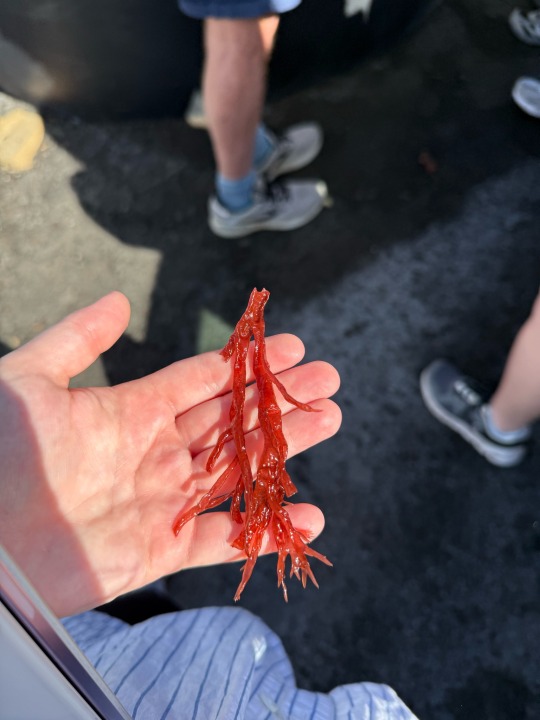
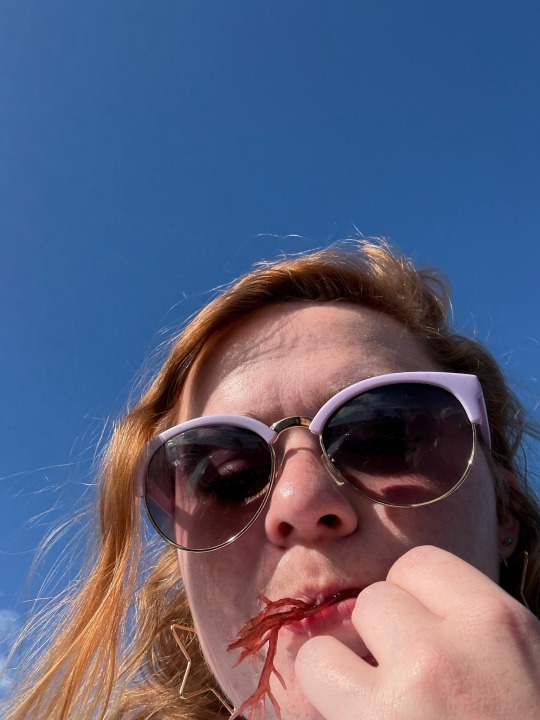

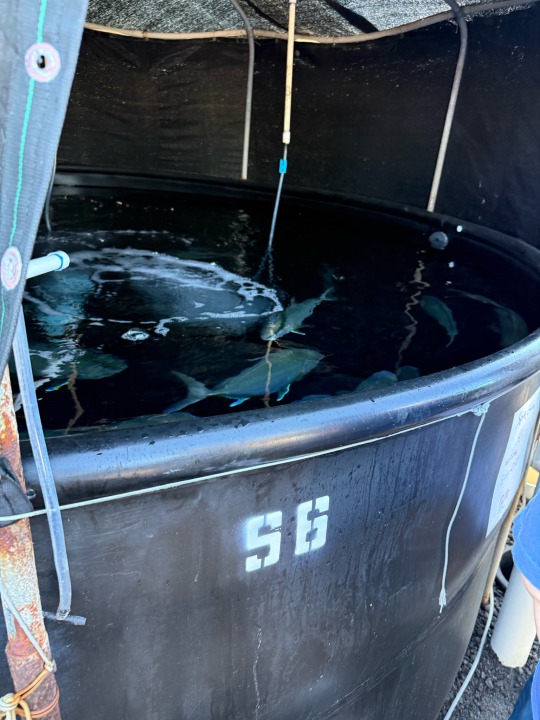

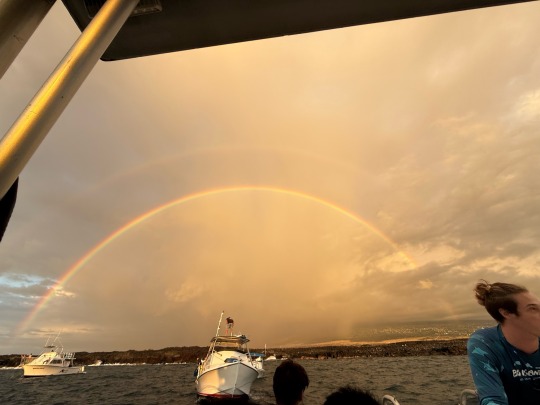
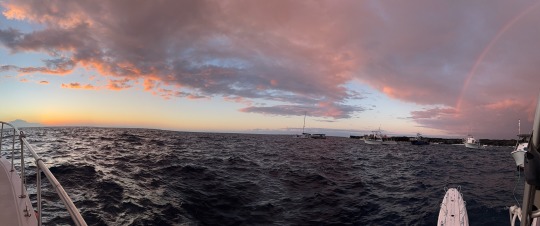
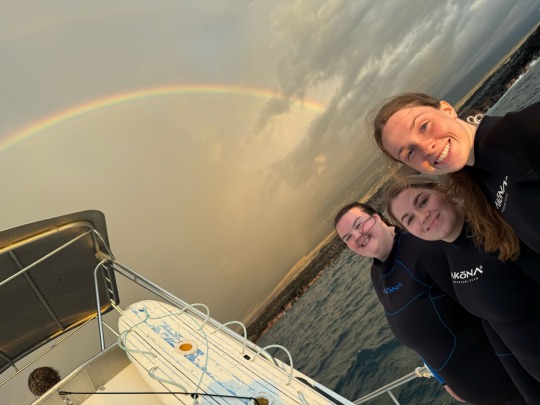
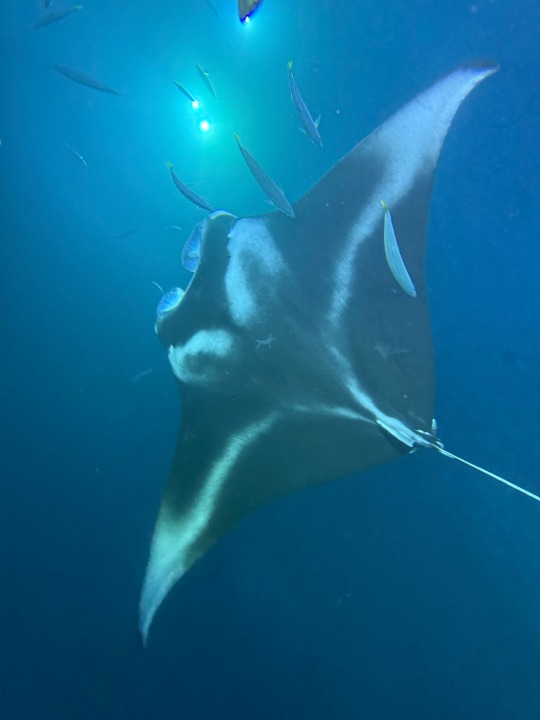
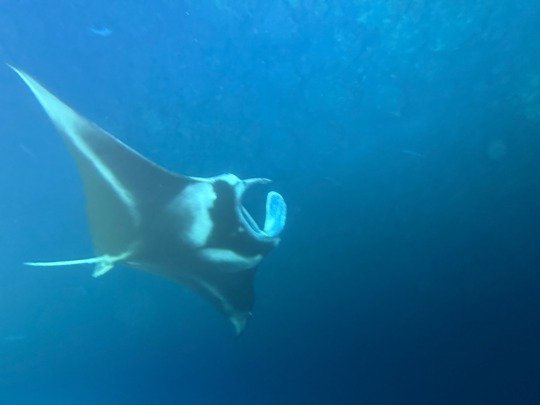
0 notes
Text
Day 12
And for the day eery student in this course has been waiting for: BEACH DAY!
Jocelyn and I were up bright and early, throwing clothes over our swimsuit to meet for a course breakfast. As good as the little cafe looked, the entire group was impatient (and perhaps hungry) to get to the beach, so we decided on a McDonald’s breakfast on the road so we could spend more time in the water. Pancakes, eggs, and sausage became my fuel for three hours of splashing around in the water (after a thorough coating of reef safe sunscreen of course). So, thank you study USA for that breakfast.
The beach turned out to be at a State Park that was apparently used one time as military site, because it had several posted ordinances to ‘not touch grenades’ if you find them and to immediately call 911. That did not deter me on my quest for sun, sand, and salt water. I’m proud to say I was the first in the water and the last to get out. The water was colder than I thought, but with the sun out It was quite pleasant! Me, Jocelyn, Anna, and Dr. Hom bounced around in the waves (looking forward to seeing Dr. Hom’s go pro footage) until it was absolutely time to get out.
Then it was hopping in the car and heading for lunch (thank god I packed dry clothes for this trip) because we ended up at an upscale tourist mall. I forwent an actual lunch, and instead visited the art gallery there. I found a lovely handmade piece of glass art for my travel wall at home. It’s made by an artist who lives in Volcano National Park, and she takes molds of the lava flats and then blows glass murals into them. Worth skipping lunch for!
Finally, we got back in the car and hauled it to Kona to make it to our snorkel reservation. On a 50 foot catamaran we set sail to Captain Cook Bay. I opened myself a tab and enjoyed my sail in style with a Pina coloda on the net deck. We were so lucky to not only see a mom and calf humpback whale as well as the classic helix jump of a whale on the horizon!
At the bay, one of our guides explained the cultural significance of the bay to us. Ancient Hawaiians used the cliffs as a vertical burial ground and believed it to be a pathway for the gods, and warriors would fight for the honor to bury royalty there only to sacrifice their lives in the end so their family would have the chance to live with royalty.
After giving us snorkels, flippers, and a float, they set us free in the bay with the only instruction being ‘stay in the water’ because if you come in on a boat you HAVE to leave on a boat. The only way to access the monument is to hike down and back up! I’d never swam with flippers, so I had to teach myself how, but after getting the hang of it I was ZOOMING! (I might have accidentally broken the buddy rule!)I saw so many tropical fish, and even got to close to an eel for comfort.
No whales on the way back, but we did catch a crab in a bucket that the crew pulled out of the water. It was over too soon, and then we were off to the hotel where we checked in and got ready for Jocelyns BIRTHDAY DINNER.
For dinner, the crew was me, Jocelyn, Anna, Morgan, Dr. Hom, and Noah. I had a phenomenal parmesan crusted mahi and a wonderful chocolate cherry cake. By the time we made it back to the hotel, I was practically dead on my feet.
Today’s achievement: over 6 hours in the sun and no sun burn!
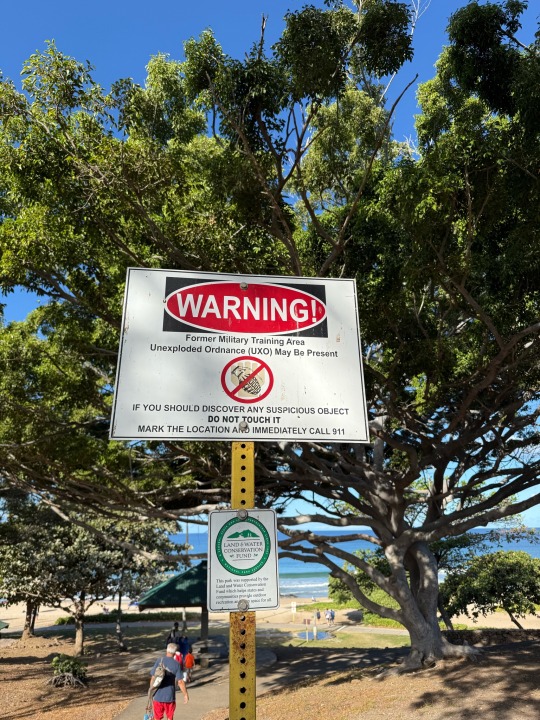
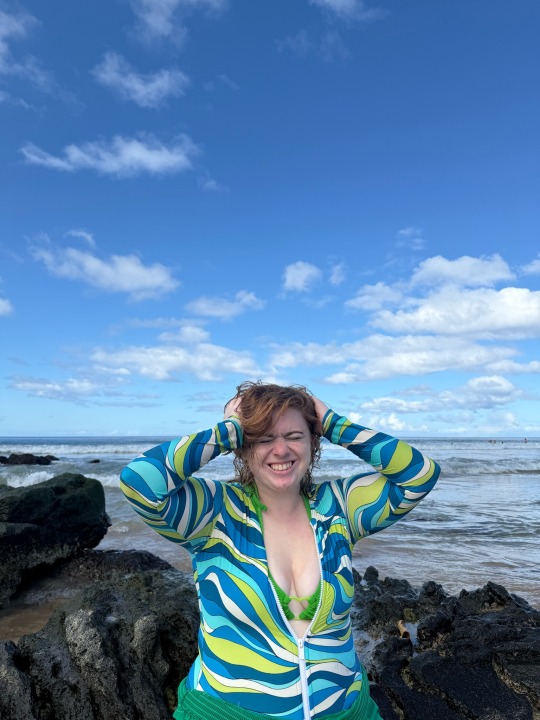
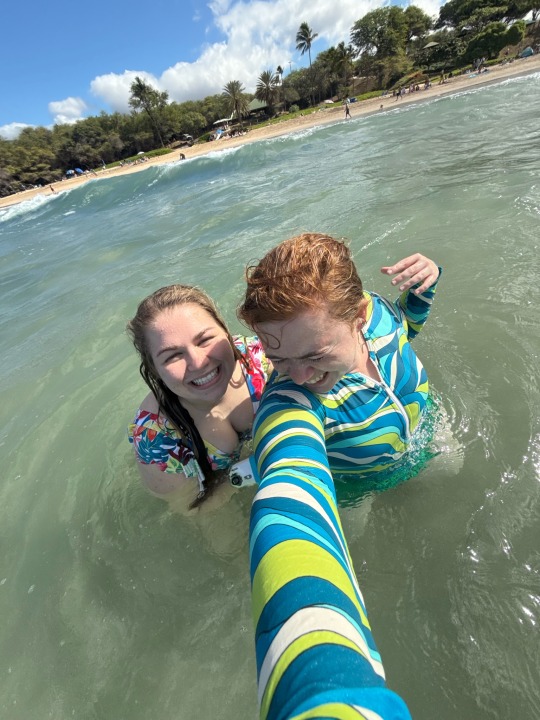
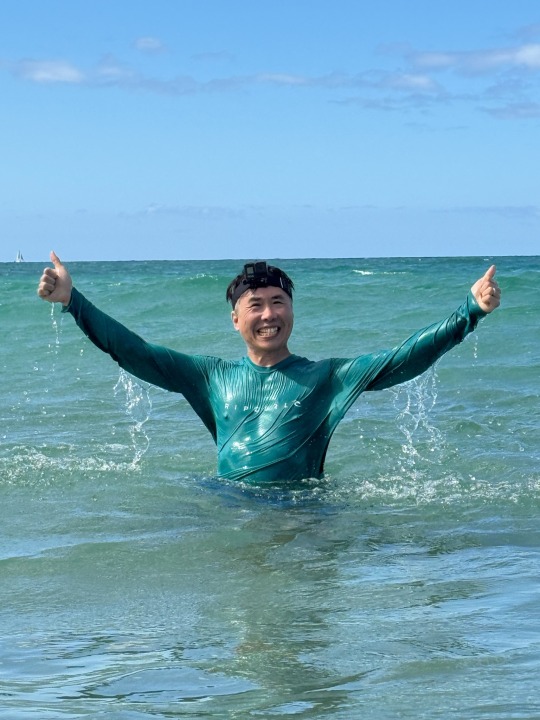
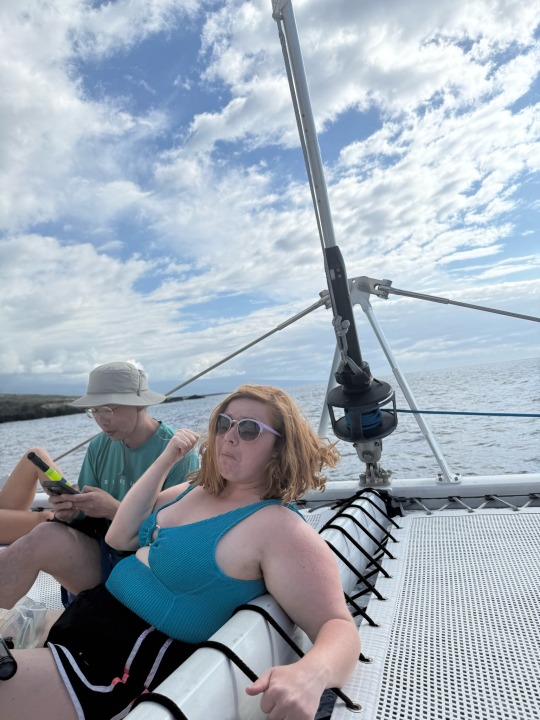
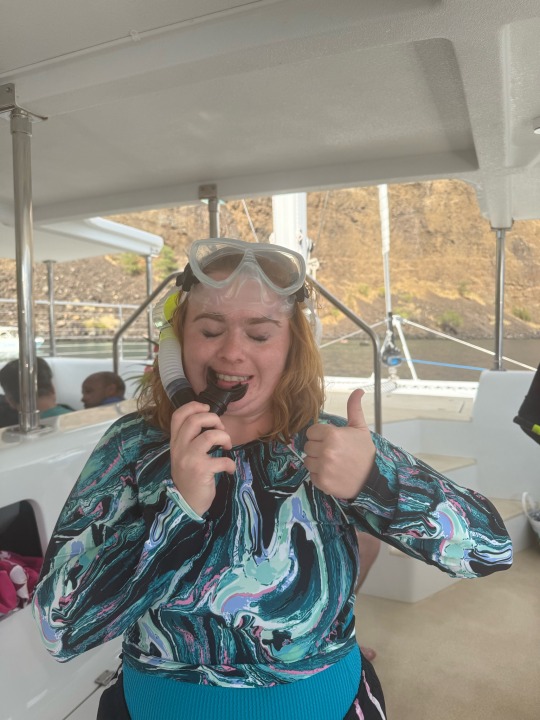
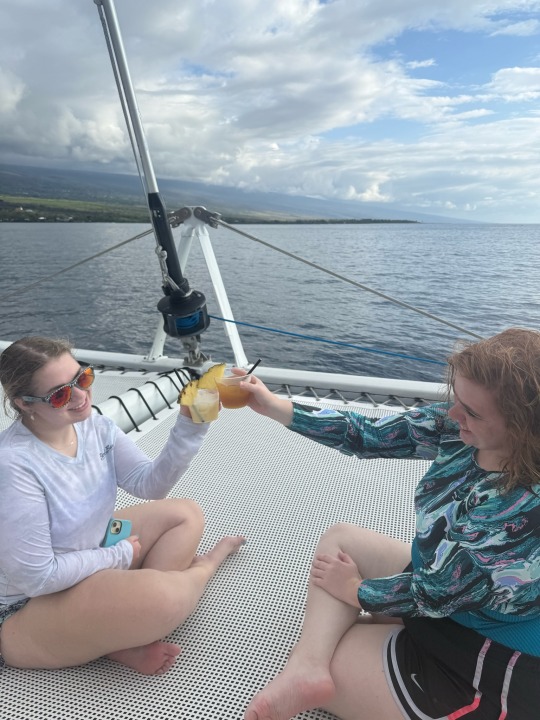
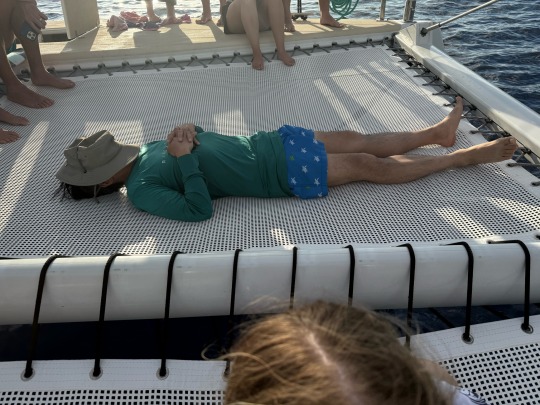
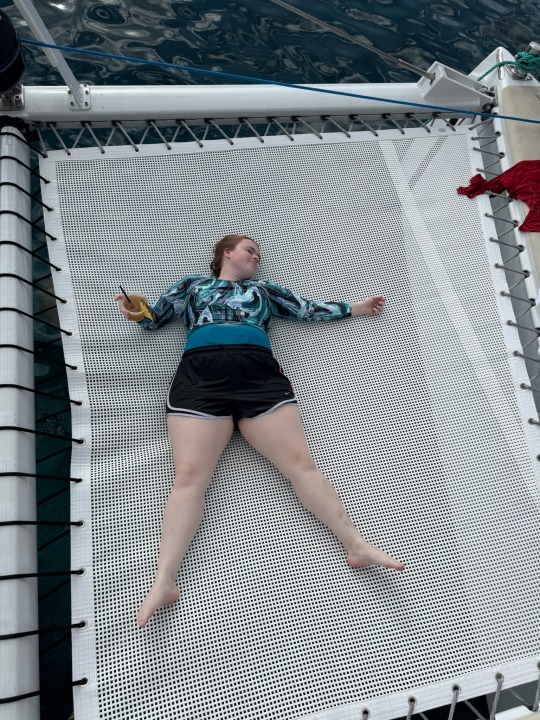
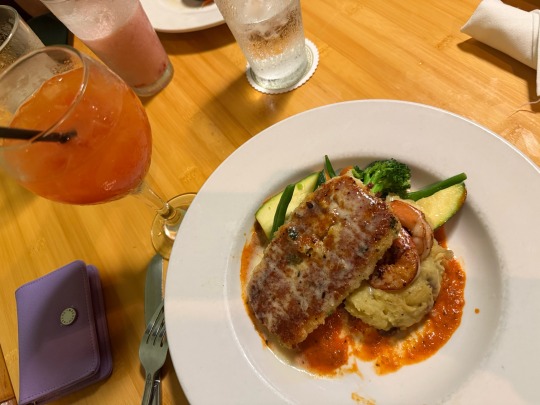
0 notes
Text
Day 11 Blog
Day 2 in Waimea! This morning we kicked off the morning with Starbucks for breakfast for another big day of lab work. Starbucks is Starbucks no matter where (was disappointed not to find the Hawaii been there mugs), so I got a refresher and a danish. Starbucks was less impressive, however, than one of the fullest arc of rainbow I’ve ever seen. It took up the whole sky and hillside, very close- not distant at all- and incredibly vibrant. What a perfect way to start the morning- and it was even in the direction of HPA! The closer we got, the more vibrant it got and even briefly turned into a double rainbow! It was absolutely beautiful and I sent it to everyone I know IMMEDIATELY. I think I took more pictures of this rainbow than I took on the hike yesterday.
So, post rainbow, Starbucks in hand, we tucked in for Dr. Hom’s lecture about genetic sequencing, PCR, and metagenomics. In which, I lived one of my actual nightmares (Dr. Hom called on me and made me come to the front of the class to answer a question in front of a bunch of high schoolers and biology majors, and there was a miscommunication on my first answer- which was actually correct- so then I kept just guessing which were all wrong of course which only flustered me worse. Eventually we got on the same page and I only cried a little bit!) I felt like I was physically manifesting a dunce cap, but I do remember what we talked about so I guess it worked! Though I hope we start picking on the other not-biology major!! After the lecture, we started our PCR amplicon run, which was adding H20, Taq, DNA templates, and primer to test for bacteria, fungi, nitrogen fixers, and plant DNA. It ran in the program to be heated up to break down the DNA. This is expanded upon in my lab journal.
At 11:30ish, we paused to let the PCR run while we all went to a local farmers market with local goods, yummy food, and lots of free range chickens. I started my farmers market by buying 1/2 a pound of coffee for my dad and hand carved kitchen cooking utensils for my mom and grandma. Then it was time for a snack because my Starbucks breakfast was starting to fail me. I ended up trying Hawaiian Sea Grapes with ponzu sauce. They were very… oceanic tasting with a nice soft yet crunchy texture. I enjoyed them but think they’d be even better with some lemon just to cut the salt factor. Then I decided I better eat some real lunch and ended up at a Korean-fusion food truck. I tried a pork belly kimchi sandwich as well as a beef short rib golden bao bun. Both very tasty and yet spicy. A little more perusing and then it was back in the van to go back to HPA.
Back at HPA it lab, lab, and more lab. We learned how to make agar for our PCR, and once it was set properly we set out samples into the gel electrophoresis plate. Dr. J guided us into seeing the genetic sequencing. We finished up our findings, and then moved on to talk to the Nanopore rep about their genetic sequencing software. What was cool about their software and hardware is that it’s completely portable making it perfect for field work- which they used during Ebola and COVID-19 outbreaks which I thought was really interesting!
After all that, we started cleaning up the lab and saying goodbye to our HPA friends and headed out for dinner. I tried Korean food with Jocelyn, Noah, Dr. Hom, and Anna- and had one of the best plates of food I’d had on this trip. Very very yummy kalbi ribs!!
Goodnight to this trips course load and hello to tomorrow’s beach day!

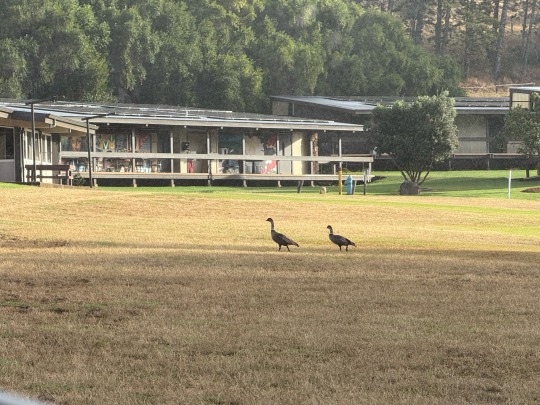
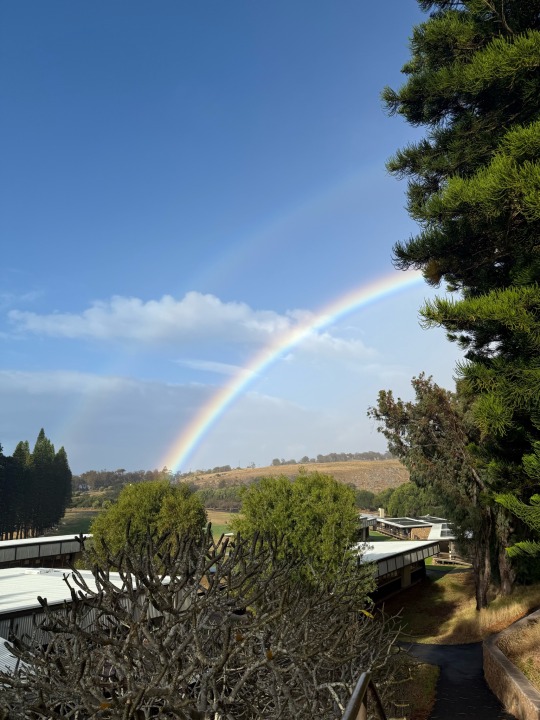
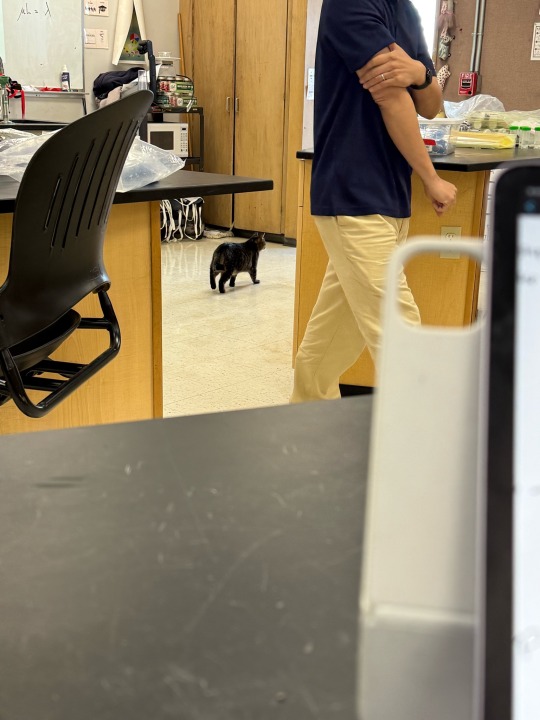
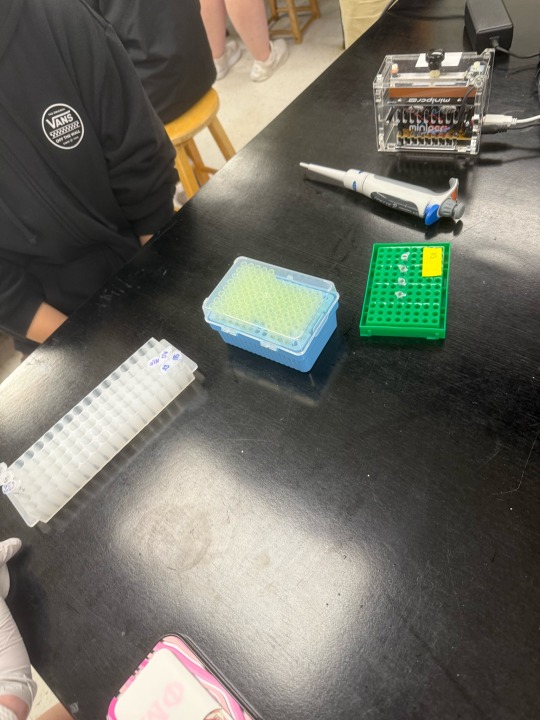
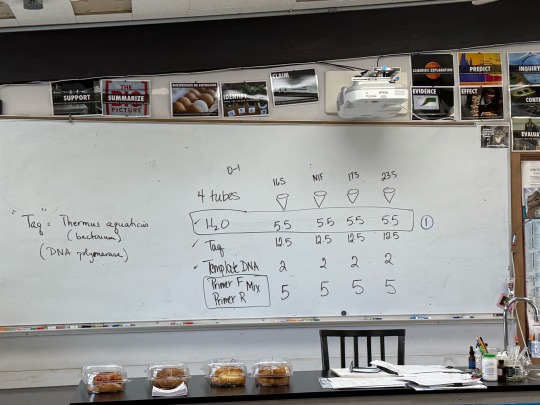
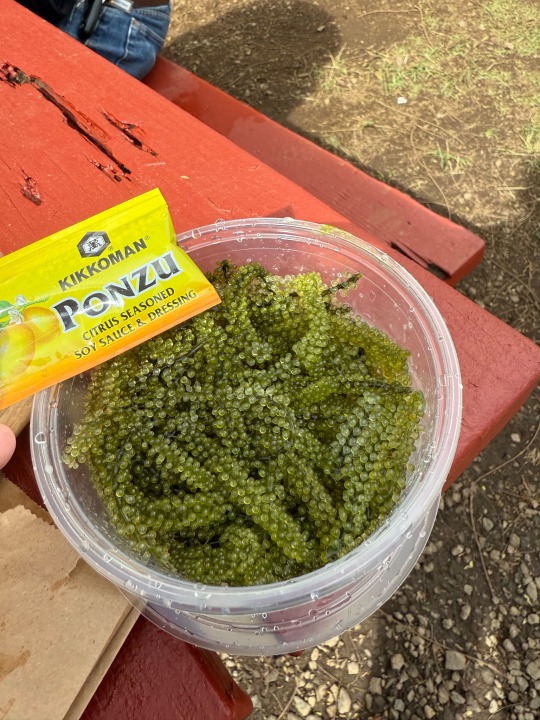
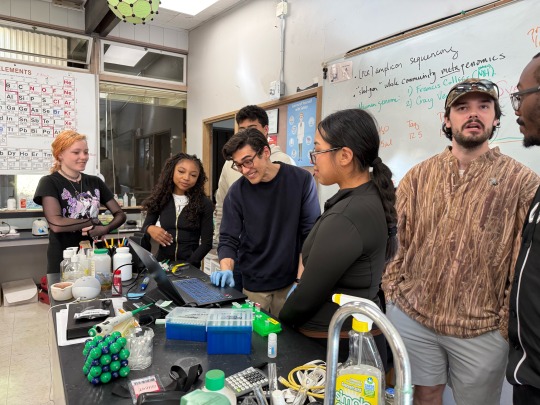
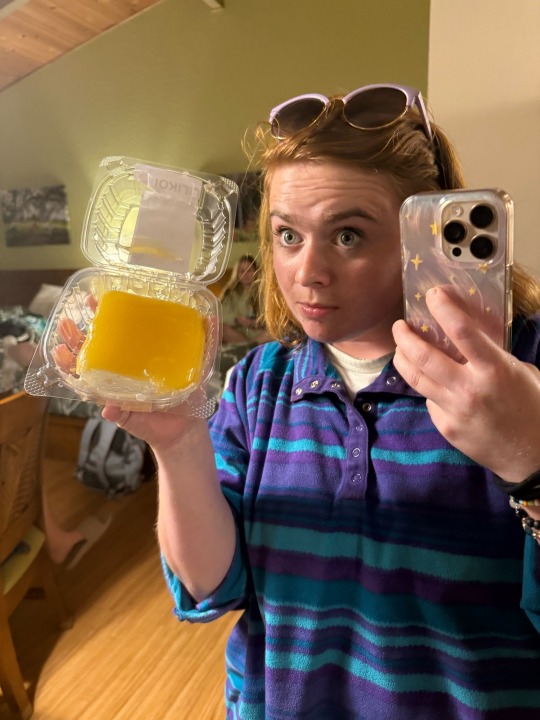
0 notes
Text
1/11 Blog
Day 2 in Waimea! This morning we kicked off the morning with Starbucks for breakfast for another big day of lab work. Starbucks is Starbucks no matter where (was disappointed not to find the Hawaii been there mugs), so I got a refresher and a danish. Starbucks was less impressive, however, than one of the fullest arc of rainbow I’ve ever seen. It took up the whole sky and hillside, very close- not distant at all- and incredibly vibrant. What a perfect way to start the morning- and it was even in the direction of HPA! The closer we got, the more vibrant it got and even briefly turned into a double rainbow! It was absolutely beautiful and I sent it to everyone I know IMMEDIATELY. I think I took more pictures of this rainbow than I took on the hike yesterday. We also saw Ne-Ne's for the first time, almost two week in!
So, post rainbow, Starbucks in hand, we tucked in for Dr. Hom’s lecture about genetic sequencing, PCR, and metagenomics. In which, I lived one of my actual nightmares (Dr. Hom called on me and made me come to the front of the class to answer a question in front of a bunch of high schoolers and biology majors, and there was a miscommunication on my first answer- which was actually correct- so then I kept just guessing which were all wrong of course which only flustered me worse. Eventually we got on the same page and I only cried a little bit!) I felt like I was physically manifesting a dunce cap, but I do remember what we talked about so I guess it worked! Though I hope we start picking on the other not-biology major!! After the lecture, we started our PCR amplicon run, which was adding H20, Taq, DNA templates, and primer to test for bacteria, fungi, nitrogen fixers, and plant DNA. It ran in the program to be heated up to break down the DNA. This is expanded upon in my lab journal.
At 11:30ish, we paused to let the PCR run while we all went to a local farmers market with local goods, yummy food, and lots of free range chickens. I started my farmers market by buying 1/2 a pound of coffee for my dad and hand carved kitchen cooking utensils for my mom and grandma. Then it was time for a snack because my Starbucks breakfast was starting to fail me. I ended up trying Hawaiian Sea Grapes with ponzu sauce. They were very… oceanic tasting with a nice soft yet crunchy texture. I enjoyed them but think they’d be even better with some lemon just to cut the salt factor. Then I decided I better eat some real lunch and ended up at a Korean-fusion food truck. I tried a pork belly kimchi sandwich as well as a beef short rib golden bao bun. Both very tasty and yet spicy. A little more perusing and then it was back in the van to go back to HPA.
Back at HPA it lab, lab, and more lab. We learned how to make agar for our PCR, and once it was set properly we set out samples into the gel electrophoresis plate. Dr. J guided us into seeing the genetic sequencing. We finished up our findings, and then moved on to talk to the Nanopore rep about their genetic sequencing software. What was cool about their software and hardware is that it’s completely portable making it perfect for field work- which they used during Ebola and COVID-19 outbreaks which I thought was really interesting!
After all that, we started cleaning up the lab and saying goodbye to our HPA friends and headed out for dinner. I tried Korean food with Jocelyn, Noah, Dr. Hom, and Anna- and had one of the best plates of food I’d had on this trip. Very very yummy kalbi ribs!!
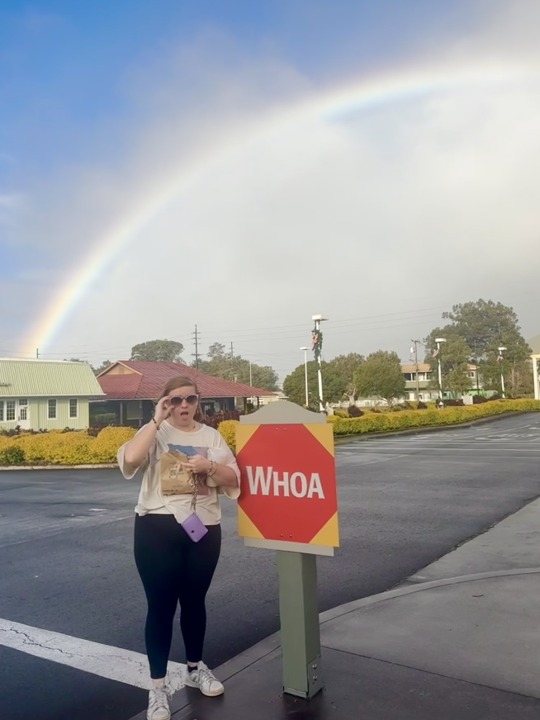
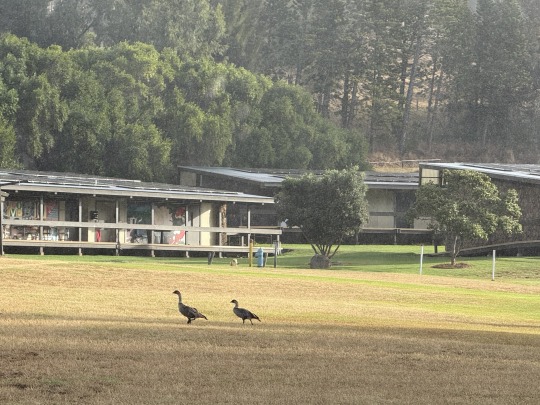
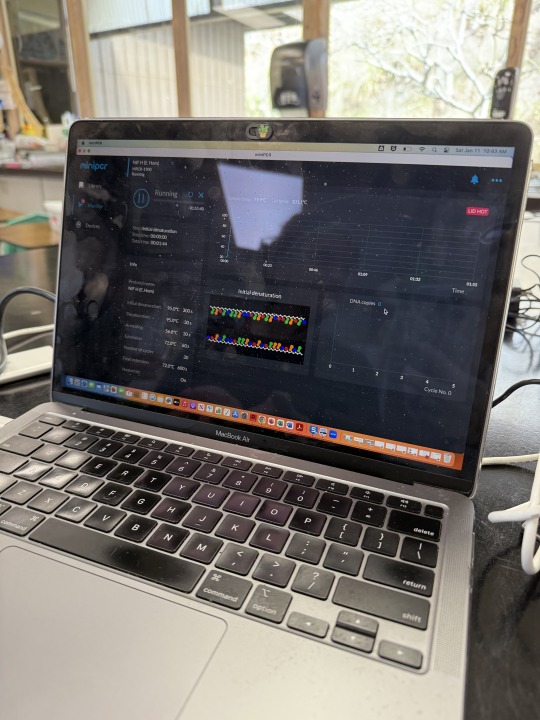
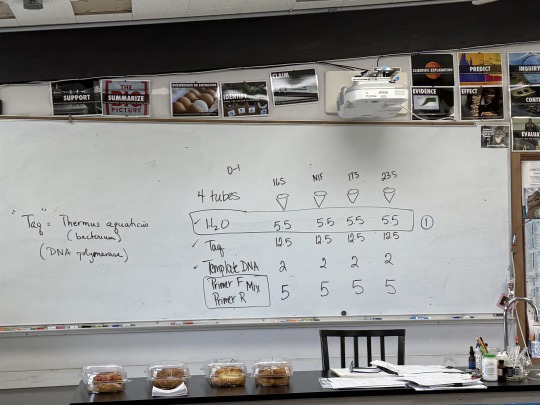
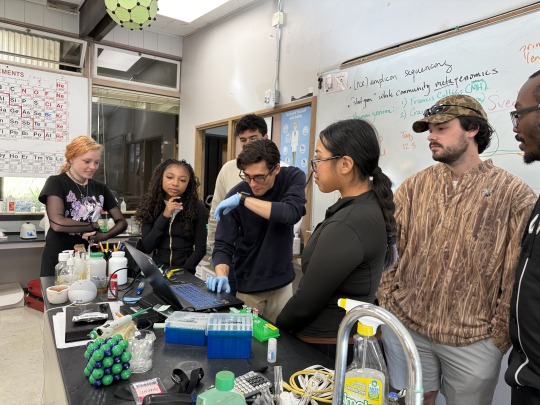
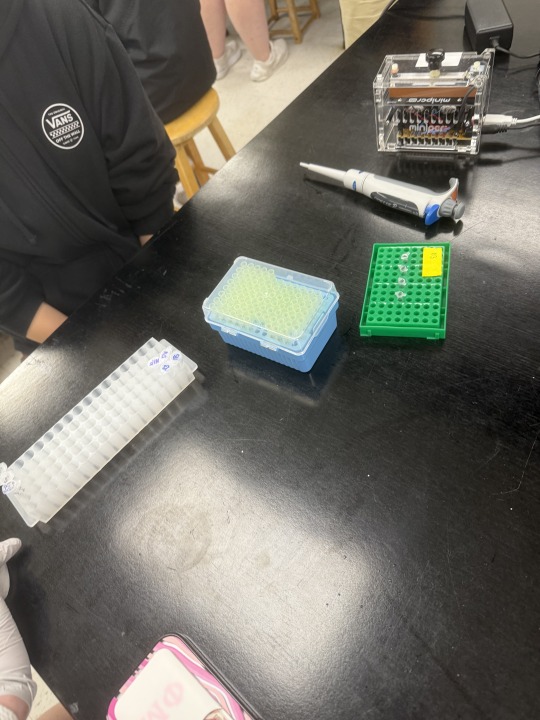
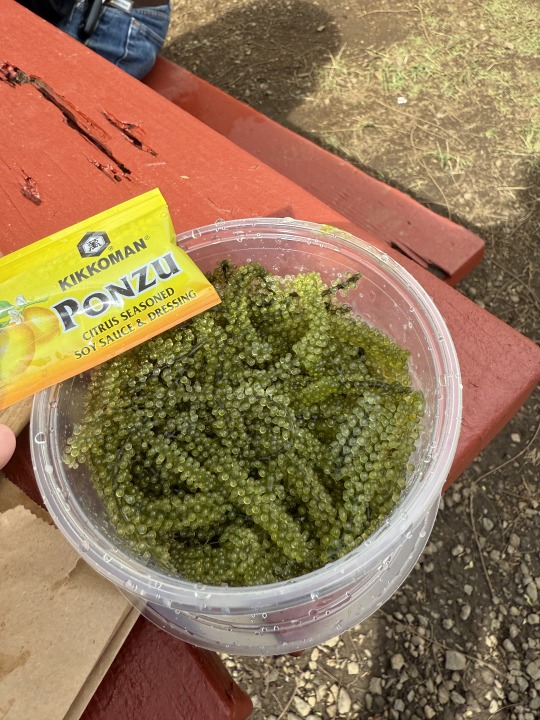
Goodnight to this trips course load and hello to tomorrow’s beach day!
0 notes
Text
1/10 blog
Today we woke up for the first time in Waimea! Rooming with Jocelyn, we slept so good that we both slept through her ringing alarm for fifteen minutes straight. Then, it was a brief breakfast where I had another bagel (no Parmesan today :( ), fresh papaya, my leftover poke, and a banana. Then it was off to our first day at Hawai’i Preparatory Academy.
This is one impressive school. It’s a student of roughly 389 high school students from around 24 different countries as well as locals from this area. They teach Hawaiian language and culture classes, as well as language classes in Spanish, Chinese, and Japanese. Their high school lab is nicer than most of the labs from my freshman and sophomore years of college. There’s horseback riding and plenty of sports as well.
Here, we were introduced to Dr. J, who has a tie to Mississippi (got her doctorates at Southern Mississippi), as well as grew up in Mobile, Alabama. We started the morning with a miniature lecture from Dr. Hom about the experiments we were running. Then, we were moved to another room to meet with two Kumas. Kumas are Hawaiian culture experts that teach at the Academy as well as guest lecturing around Hawaii. Kumo Ka’ai Spencer was the one that primarily spoke to use about the ethical use of endangered but ritually reverent Hawaiian resources like Koa wood and Ohia flowers. The other Kumo whose name I didn’t catch, spoke about making traditional canoes with limited resources.
After a pizza lunch, the school’s marine biology and scuba (yes these are classes taught here) took us on a STEEP uphill hike through a ranching field up into a protected native forest. Unfortunately due to the congestion I’ve developed, I only made it an 1/8th of the way up. Which was still almost 400 ft elevation gain, so would be difficult even if I was at my best. While I regret not seeing the Native forest, the view from 1/8th in was still phenomenal. Our guide offered homemade lilakoi limeade (passion fruit limeade) as a refreshment back at the bottom.
At around 3 pm, we tucked in to finish our day in the Lab. It took two hours to extract DNA from our soil sample. I’m on team Mamaki which was testing the Control sample. My sample was C2 which was the SL1 solution with a SX enhancer. It was a ten step process with lots of pipetting, vortexing, centrifuging, and discarding, which actually ran an hour over our lab time (RIP our plans to go to KTA), and each step was recording into our lab journals.
Once Dr. J analyzed our results, and unfortunately, the samples from Koa and Koawiki didn’t have much results, neither did control but that was expected. O’hia samples however turned up with a lot of DNA which will be important for tomorrow.
Finally, we dropped our volcanic samples into their liquid, cleaned up the lab and went on our way. Noah’s van (which he admitted we were the funny van) made a pre dinner stop at McDonald’s to try their regional menu (HELLO i need the Guava crème pies to be a national menu offering they are so so good!!) and then Noah, Jocelyn, Lexi (UH), Jacelyn (UH), and I had lots of laughs over Vietnamese for dinner!
Long day left me too tired to shower after writing all this. Looking forward to more lab work tomorrow.
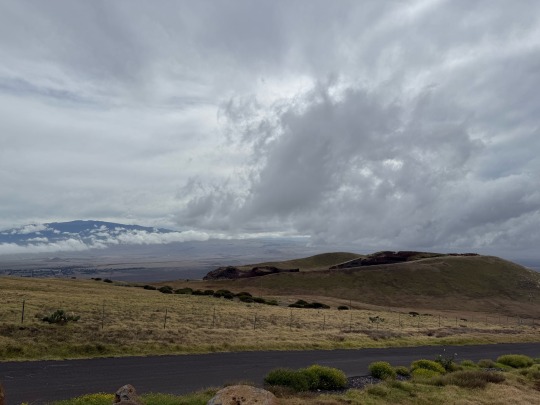
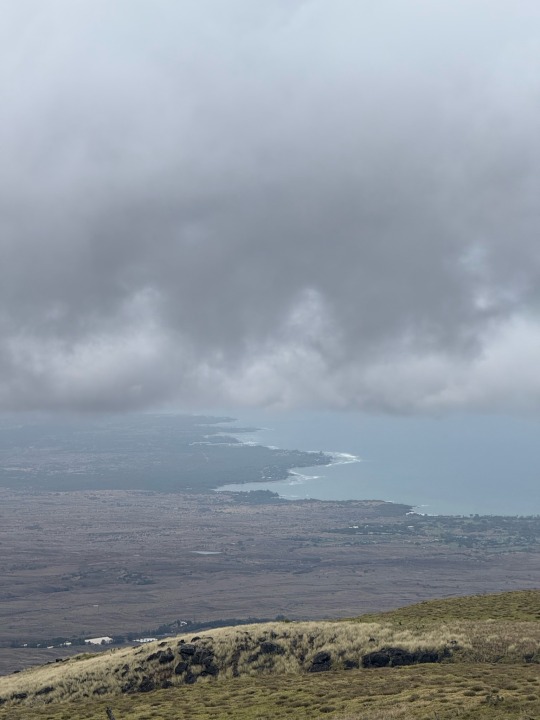
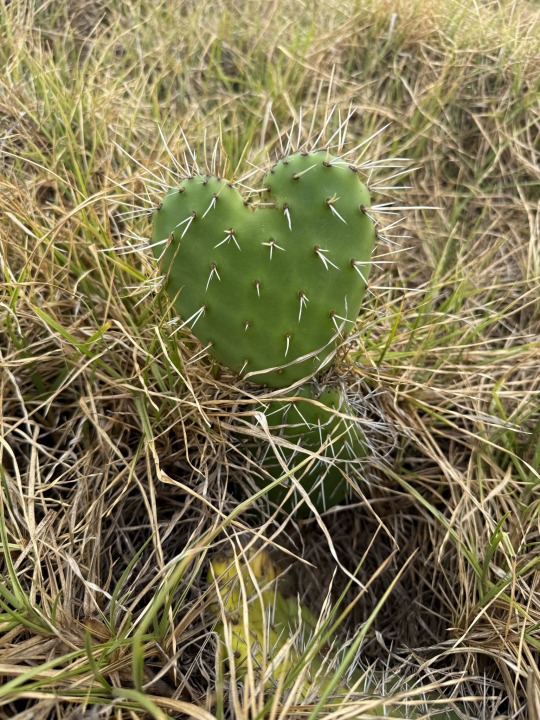
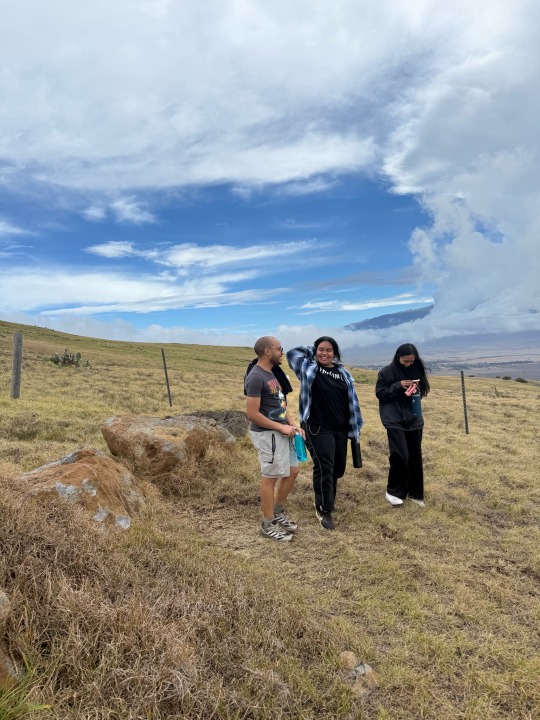
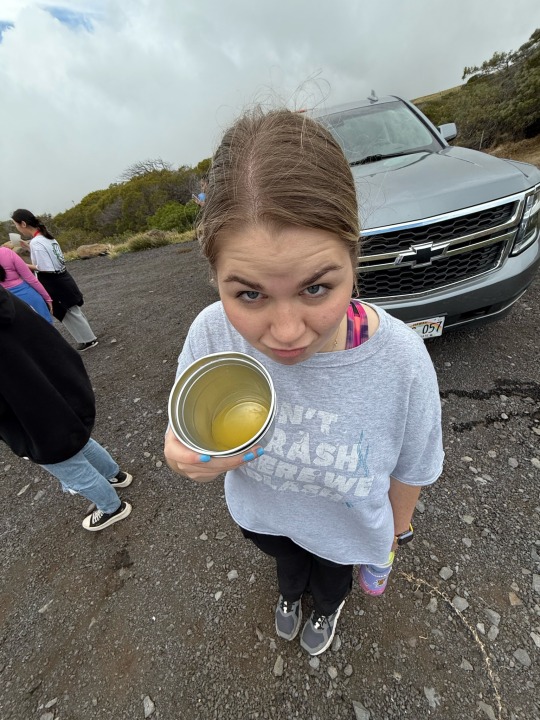
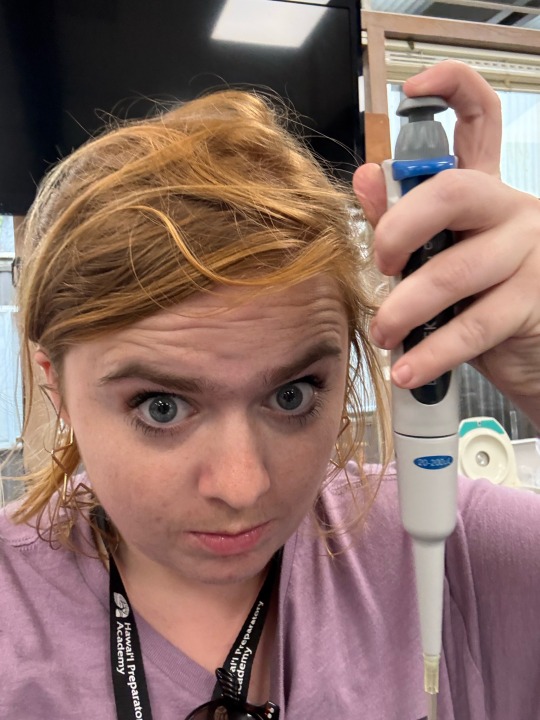
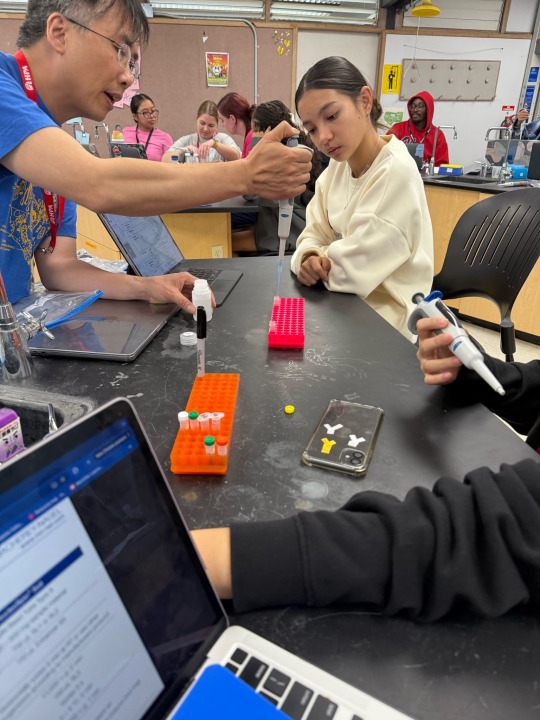
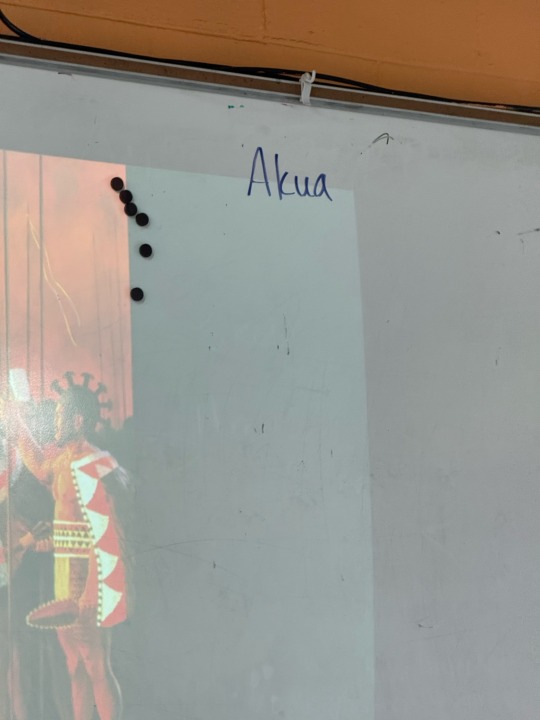
0 notes
Text
January 10th Blog
Today we woke up for the first time in Waimea! Rooming with Jocelyn, we slept so good that we both slept through her ringing alarm for fifteen minutes straight. Then, it was a brief breakfast where I had another bagel (no Parmesan today :( ), fresh papaya, my leftover poke, and a banana. Then it was off to our first day at Hawai’i Preparatory Academy.
This is one impressive school. It’s a student of roughly 389 high school students from around 24 different countries as well as locals from this area. They teach Hawaiian language and culture classes, as well as language classes in Spanish, Chinese, and Japanese. Their high school lab is nicer than most of the labs from my freshman and sophomore years of college. There’s horseback riding and plenty of sports as well.
Here, we were introduced to Dr. J, who has a tie to Mississippi (got her doctorates at Southern Mississippi), as well as grew up in Mobile, Alabama. We started the morning with a miniature lecture from Dr. Hom about the experiments we were running. Then, we were moved to another room to meet with two Kumas. Kumas are Hawaiian culture experts that teach at the Academy as well as guest lecturing around Hawaii. Kumo Ka’ai Spencer was the one that primarily spoke to use about the ethical use of endangered but ritually reverent Hawaiian resources like Koa wood and Ohia flowers. The other Kumo whose name I didn’t catch, spoke about making traditional canoes with limited resources.
After a pizza lunch, the school’s marine biology and scuba (yes these are classes taught here) took us on a STEEP uphill hike through a ranching field up into a protected native forest. Unfortunately due to the congestion I’ve developed, I only made it an 1/8th of the way up. Which was still almost 400 ft elevation gain, so would be difficult even if I was at my best. While I regret not seeing the Native forest, the view from 1/8th in was still phenomenal. Our guide offered homemade lilakoi limeade (passion fruit limeade) as a refreshment back at the bottom.
At around 3 pm, we tucked in to finish our day in the Lab. It took two hours to extract DNA from our soil sample. I’m on team Mamaki which was testing the Control sample. My sample was C2 which was the SL1 solution with a SX enhancer. It was a ten step process with lots of pipetting, vortexing, centrifuging, and discarding, which actually ran an hour over our lab time (RIP our plans to go to KTA), and each step was recording into our lab journals.
Once Dr. J analyzed our results, and unfortunately, the samples from Koa and Koawiki didn’t have much results, neither did control but that was expected. O’hia samples however turned up with a lot of DNA which will be important for tomorrow.
Finally, we dropped our volcanic samples into their liquid, cleaned up the lab and went on our way. Noah’s van (which he admitted we were the funny van) made a pre dinner stop at McDonald’s to try their regional menu (HELLO i need the Guava crème pies to be a national menu offering they are so so good!!) and then Noah, Jocelyn, Lexi (UH), Jacelyn (UH), and I had lots of laughs over Vietnamese for dinner!
Long day left me too tired to shower after writing all this. Looking forward to more lab work tomorrow.
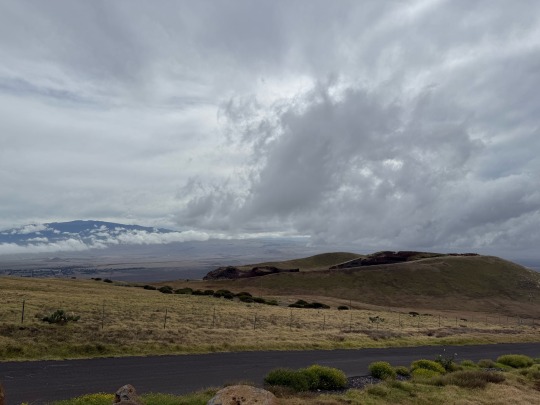
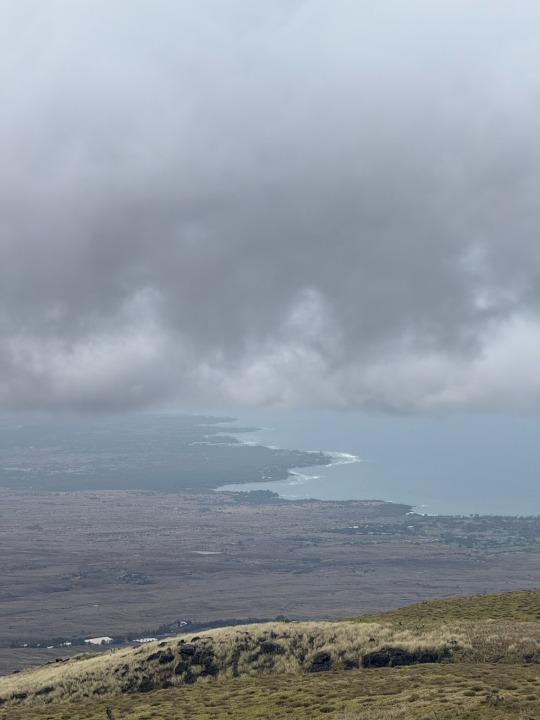
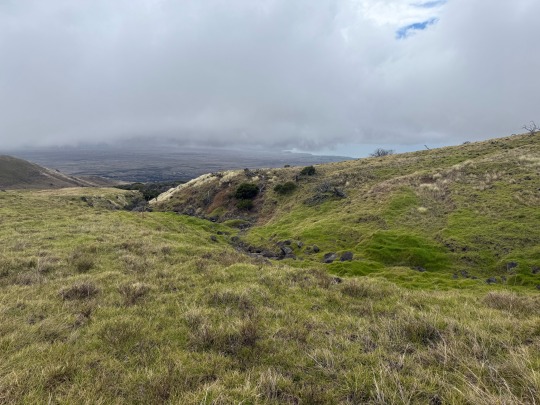
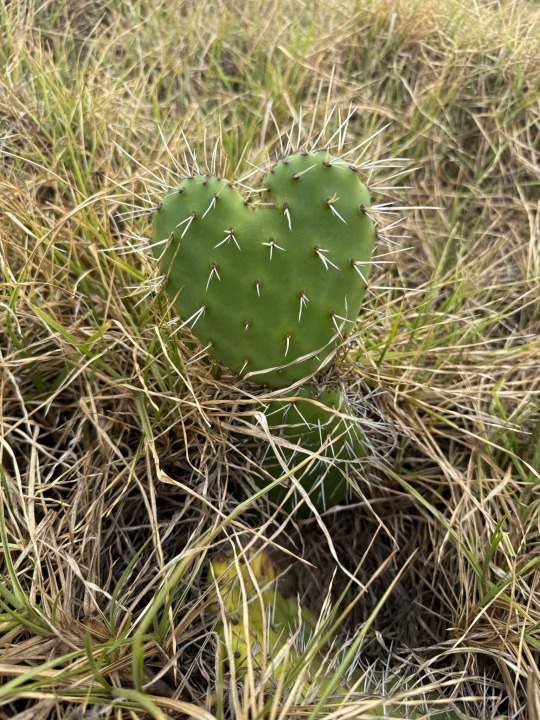
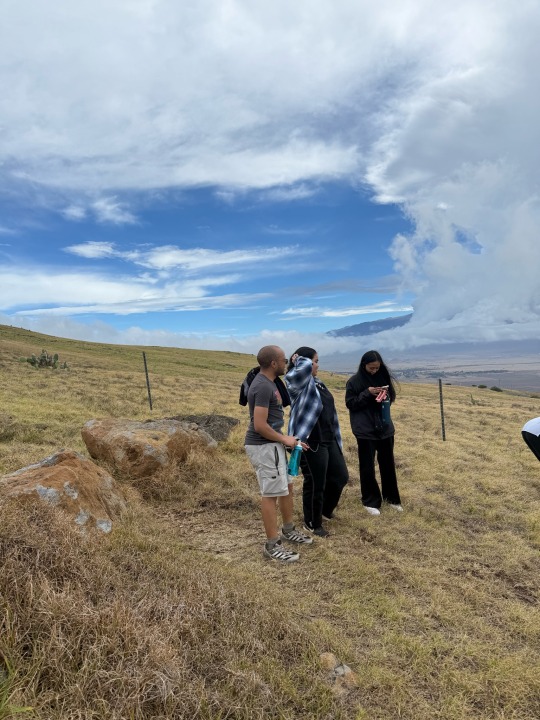
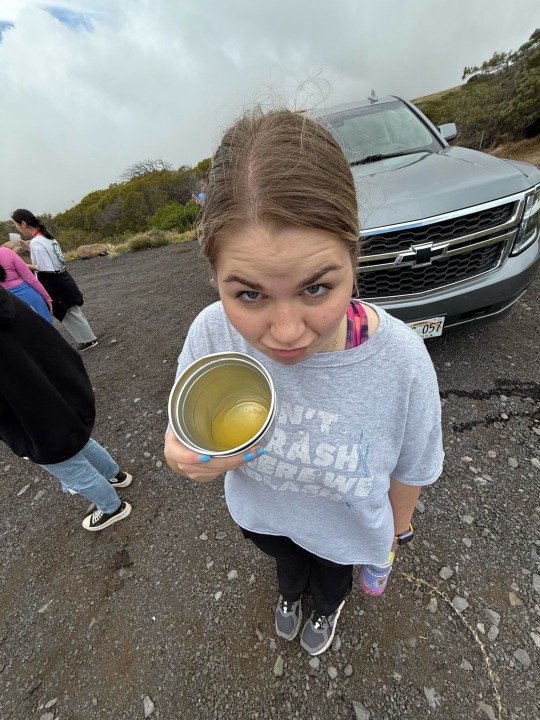
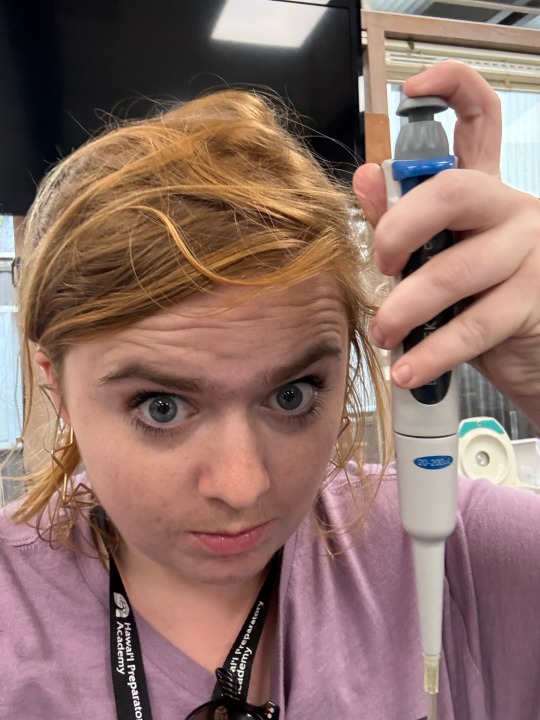
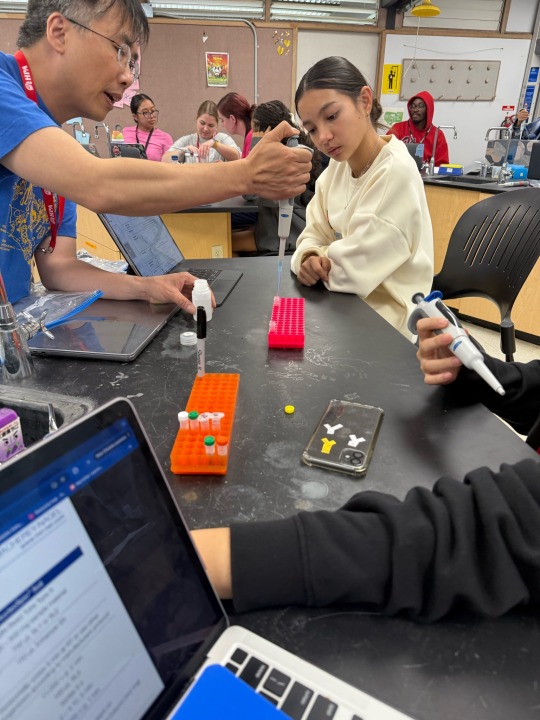
0 notes
Text
Day 7 (1/9)
Travel Day!
Starting with a late start because I put off packing until this morning. We ate our last KMC breakfast before packing everything into the vans, intense Tetris style for our drive towards Hilo. Exactly a week in Hawaii, and we’ve switched vans, which means Noah now has to deal with mine, Jocelyn’s, Anna’s, and Morgan’s nonsense while he drives. I like to think he finds us entertaining. We started our drive, squished like sardines but ready to see more of the Big Island. Our first stop? On Anna’s request, we made our first stop on our journey at a 7/11 twenty minutes outside Hilo. There, we all got various kinds of musubi treats. My brunch? A Spam Katsu Misubi, a char siu Manapua, and a POG Hawaiian soda. For gas station food it was surprisingly delicious.
Back in the car, we made it to downtown Hilo. Noah, Jocelyn, Anna, Morgan, and I decided to stick together and started at Basic Books before working our way through different stores along the water front. I really enjoyed all the second-hand, consignment, and antique stores there were. I found three thrifted Hawaiian shirts (only one is for me!) and my favorite find was a gift for my sister. A hand carve monkey pod wood trinket dish in the shape of a leave, made in Honolulu pre-statehood. I’m almost tempted to keep it for myself. Then, it was back towards the car to meet Dr. Hom for shaved ice, something I didn’t know was such a delicacy of Hawaii, but it was DELICIOUS. I got the lava flow, which was a strawberry based shaved ice with a coconut whipped cream on top, and lilikoa butter drizzled over. I could drink a bottle of the lilikoa butter all by itself. Afterwards, Noah and I breezed through the farmers market where I bought three mangos that I’m so psyched to cut up, try, and share with the class, Noah bought some guavas, and we were both harangued by a very persistent salesman of butter. The free samples were tasty though! Finally, we loaded back in the car and made another stop to Goodwill for some away-from-home thrifting.
With our shopping down, it was back on the road to Waimea. We made two stops. First to the ultra short walk to Rainbow falls, an absolutely gorgeous waterfall not too far out of Hilo. There was a gorgeous river flowing into an eighty foot waterfall. There was a small forested area that was overflowing with monstera and small sweet flowers. Absolutely gorgeous park that was surprisingly accessible for something that seemed so exotic and wild. Next we drove about forty minutes to our next point. Laupahohoe Lookout Point. This waterfront was stunning, a reminder that not all beaches are tranquil. Cerulean waters crashes against a lava rock shore in a way that made it hard not to believe in the Hawaiian spirits. The shoreline was dotted with remnants of shells and coral pieces, as well as little crabs scuttling about.
Forty more mintues of driving through some impossibly dense fog, we’ve finally made it to our home for the next three days: Waimea Country Lodge. All settled in, we went across the road for a quick dinner in the food court (Thai food and Poke for me!). Finally, back in our rooms, showered and cozy, we’re ready to start another work day tomorrow!









0 notes
Text
Day 5 (1/8)
Today, we started out with a nice chill morning, letting breakfast stretch until 8:45 AM. Another day, another Parmesan bagel with cream cheese and butter. Then, it was off to our first stop. Akatsuka Orchid Gardens. The Orchid Gardens were absolutely stunning, with so many variety’s of orchids in dozens of different shapes, sizes, colors, scents, and longevity. There I learned that a master Orchid Gardner has spent almost two decades engineering and molding the perfect orchids. These orchids are flowers that go on to win awards, and are plants that people will pay up to twenty thousand dollars for. Which, they were all very very pretty, but not price of a used car pretty. This green house has engineered orchid plants that bloom for over two months at a time (compared to the usual 1 or 2 weeks), as well as blooms that smell fragrant like perfume. Of course, I had to inspect each and every flower available, and ponder if I could send one home and actually maintain it (the answer is no, my thumbs are NOT green).
Once done at the Orchid gardens, we went back to Big Island Tea for the last time. There we worked more on Input - Output Analysis systems, which I think I was finally starting to get the hang of. When we started them, it was very frustrating to go from a non tangible but elaborate PSM, to a bare bones, this plus that creates this format. However, once we got in the swing of it, it made more sense and almost reminded me of a board game style progression. I think this form of analysis is good because it keeps you from getting lost in too many details, and should be used in tandem with PSMaps so you can delve deeper into the links your making.
Afterwards, we started fleshing out a potential experiment with bitten vs unbitten tea leaves. Anna and I played stenographer recording different variables, ideas, methods, and questions for Eliah. We decided that we’d need to parachute style wrap tea plants after shaking and inspecting bugs off, in the lowest bed where there are neat rows (where shaken but uncovered plants would serve as our control). After deliberating and pontificating our experiments, we headed up to the house for our final chat with Eliah, asking her questions about our experiment and what would work best on the farm, as well as being shown what was once a flourishing pond on the farm. We wrapped up the work day with a little more input - output and discussion recording before packing up and heading back to Volcano National Park.
Dr. Hom dropped a small group (myself, Anna, Morgan, and Jocelyn) off at the National Parks Visitor Center for a little exhibit perusing and gift shopping (I got a really really swag magnet). We started at the VC, wandered to the art gallery, before finishing at the Volcano House to hang out at the lookout viewing window while waiting for our ride back to KMC. Afterwards, I went back up the mountain with Dr. Hom and Noah to see two more lookout points where there had previously been visible lava. Unfortunately, no lava today, but plenty of steam and good company!
Tacos for dinner for our last night at KMC, tomorrow is our travel day!
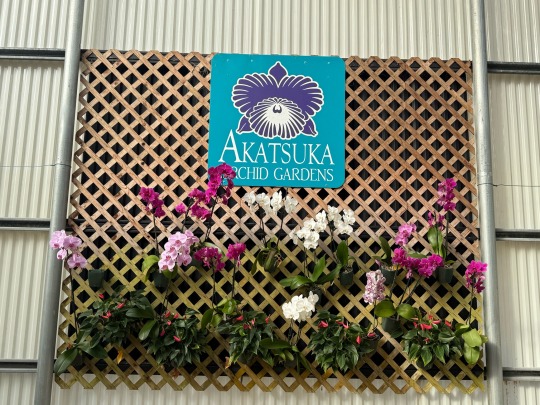
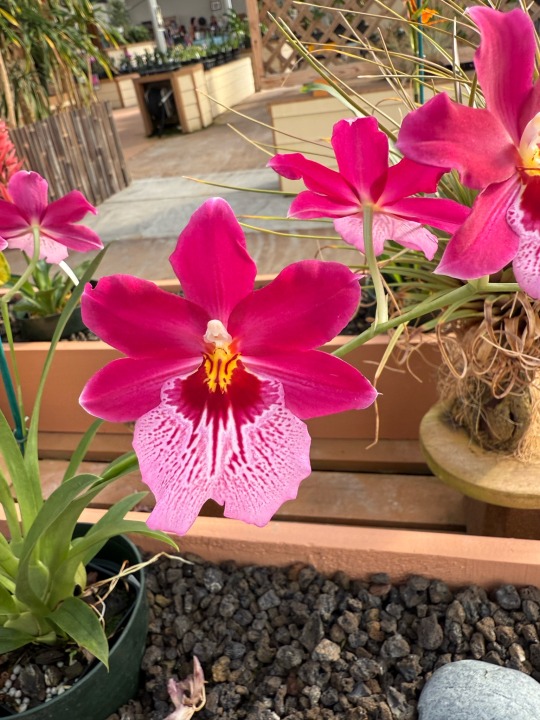

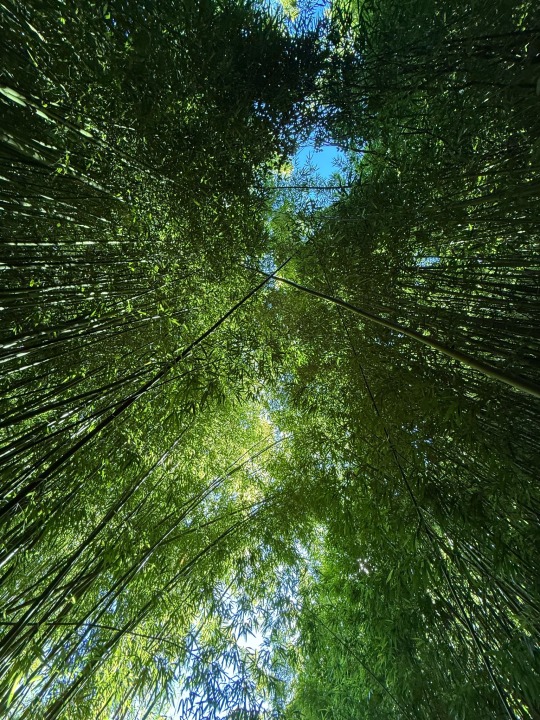
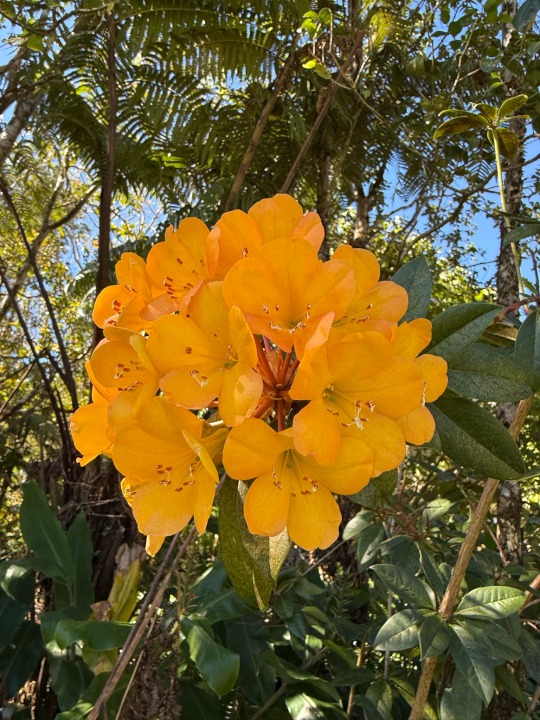
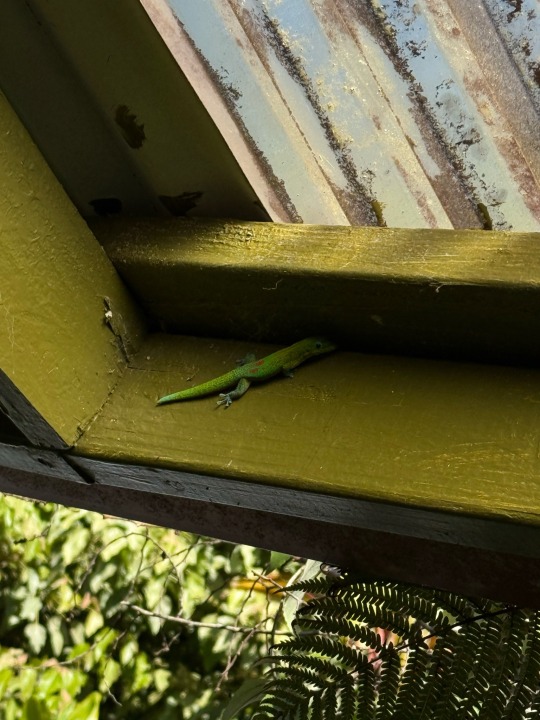
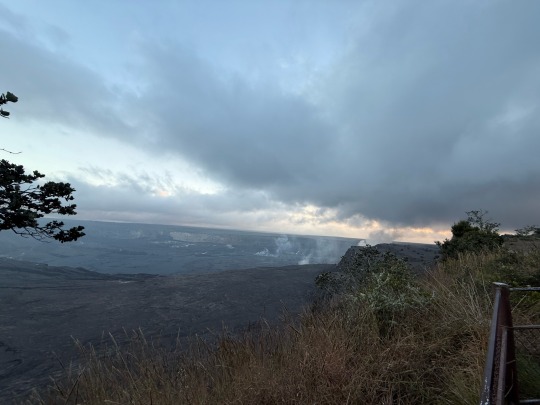
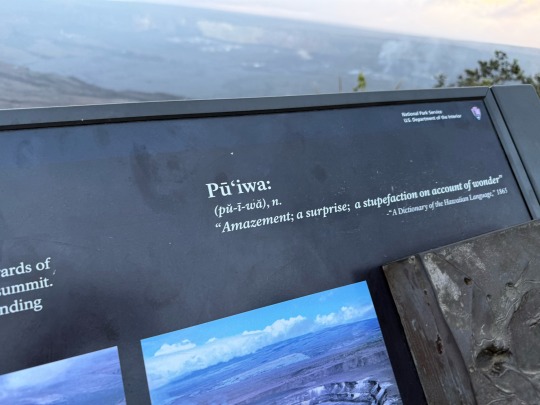
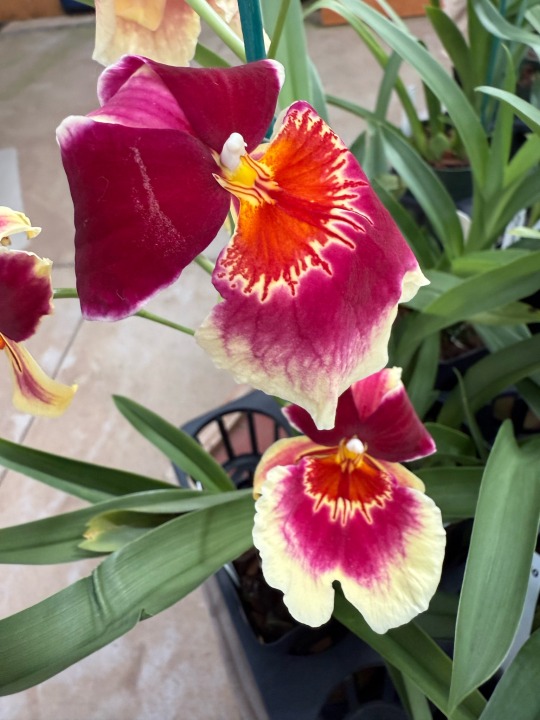
0 notes
Text
Day 4 (Jan 7th)
Good morning from the new room. This morning started off finishing some of the best sleep since I’ve been here. Quick breakfast, and then it was off to Gary’s house to learn about living in a lava field. It was an hour and so drive (had I known, i might have taken my breakfast to go), and eventually we hit ‘the end of the road’…. And then we kept driving.
Gary runs Hot Foot Photography, and is a self ascribed ‘lava junkie’ who’s already had his house burned down by lava- and then rebuilt in the same place. Gary gave us a lot of interesting information about living off grid in Hawaii. He has a completely organic garden and has managed to create soil by buying black cinder and mixing it with organic materials of dead plants on his property (pulled up weeds, drift woods, etc). His property is a little green oasis on an other wise black lava field. This lava was a smoother walk than yesterday’s lava field climb. And from his home, we went on a twenty minute jaunt and got to see the ocean for the first time since being in Hawaii. We collected some samples, took some pictures, smelled the salt,and listened to the powerful crash of waves against the jagged cliff edges. Jaunt back, and then we got to cool off while listening to our Lava Junkie recount on a map and by date, all the lava activity from the past decade (including his house burning down, which he watched while drinking champagne and snapping shots) He explained some of the gases and their reactions with air and water as Lava moves and dries around the island. He called volcanic activity the ‘heartbeat of mother earth’.
Next, was a brief run and go lunch from KTA which is a Japanese based grocery store with a lot of local and fresh foods. I got a 1/2 pound of fresh poke (delicious), some seaweed salad, and then a plate from a nearby Chinese restaurant with the best roasted pork I’ve ever eaten.
Back at Big Island Tea, we met back up with our Hilo friends, and Aliya who stuck around just long enough to let us taste our black tea after it spent the last 48 hours fermenting. Black Tea created a rich reddish amber color and had clove-y, honey, and orangey notes, it was rich but not over powering. Like Unsweetened tea, but good. After gifting us some of our own tea brewing tools, Aliya said goodbye for the last time and let us hang out on the farm to work on our PSM’s and Input/Output maps.
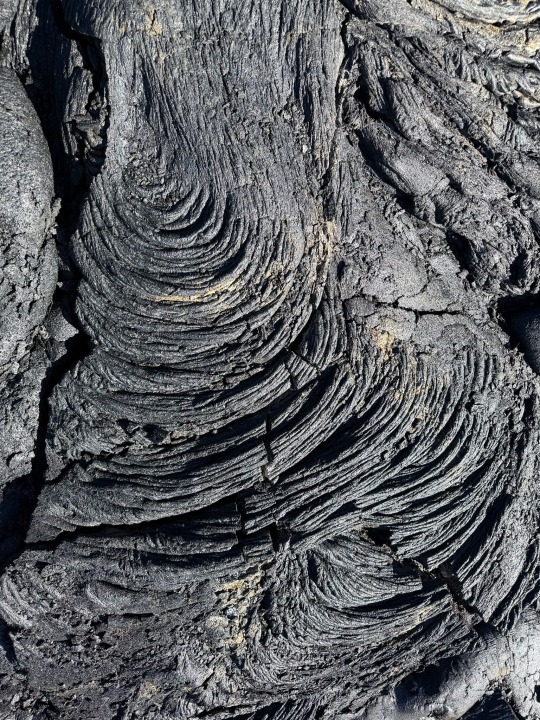
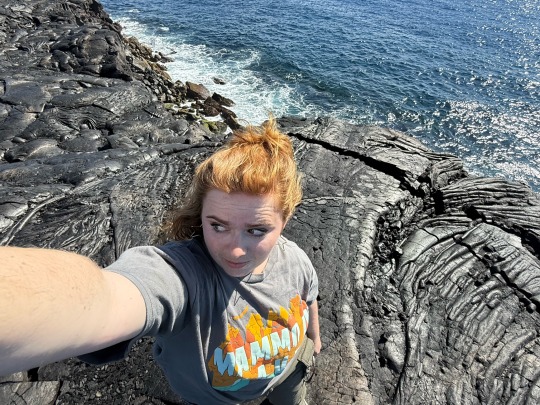
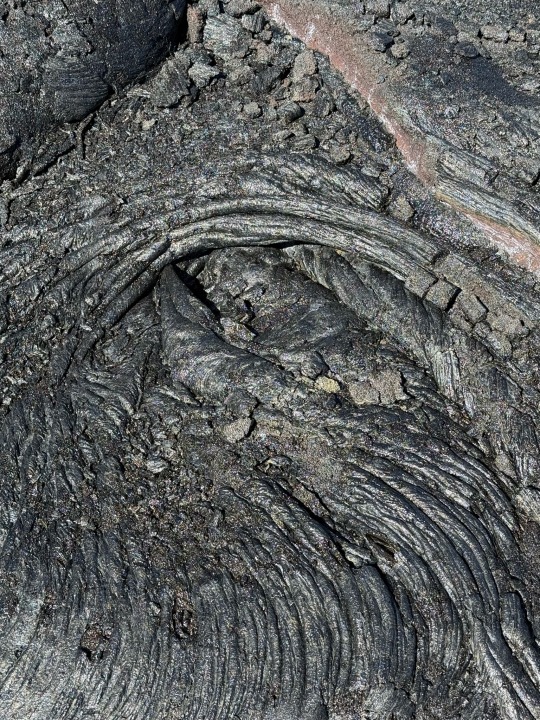
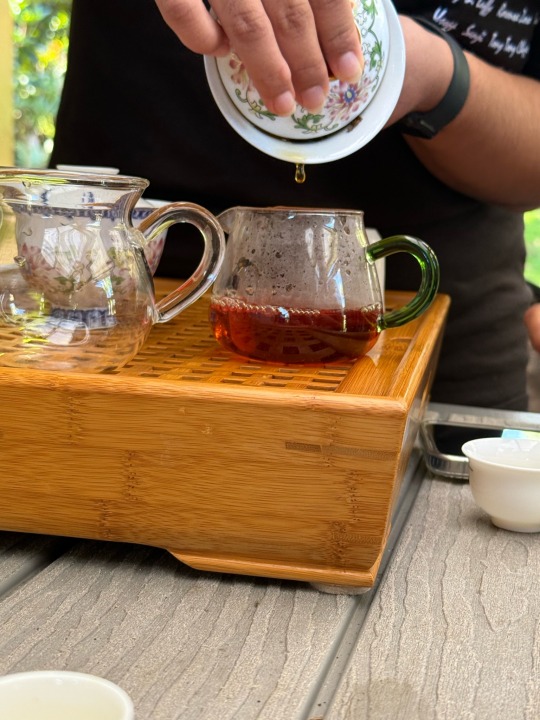
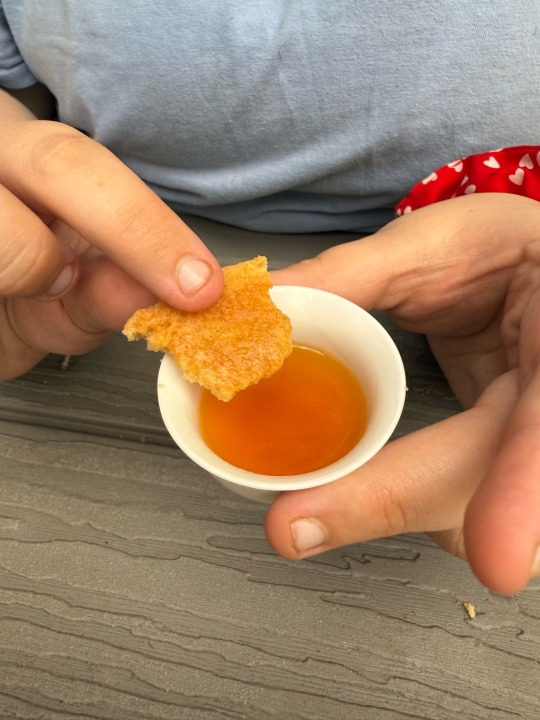
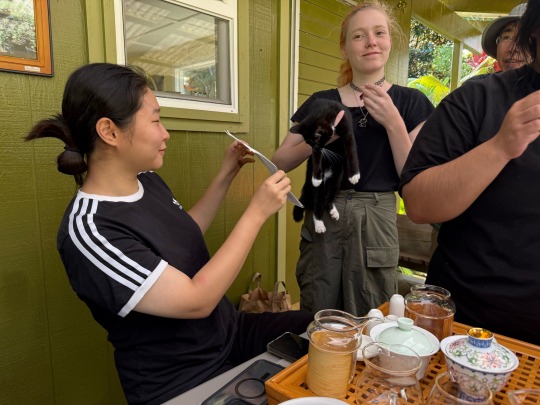
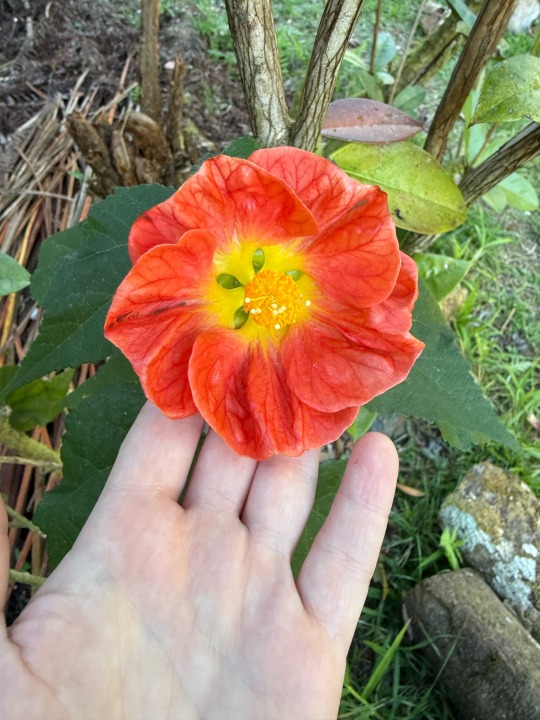
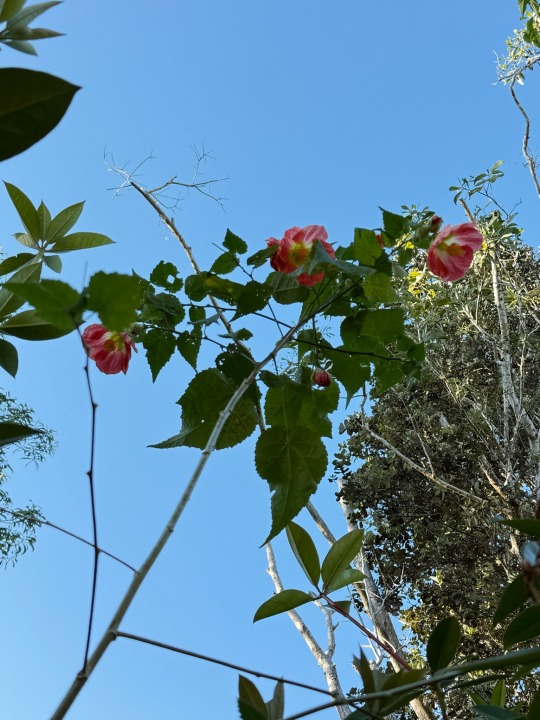
0 notes
Text
Day 3 (Jan 6th)
Today was the day I was most excited for. All. The. Hiking.
Kiliaeau Iki Trail was our first stop after another bagel breakfast (I am putting a DENT in the Parmesan bagels) It was a lovely drive through the forest at 8AM with sun streaking through the foggy jungle, to a trailhead parking lot. The first part of the hike was jungle with lush greenery and moss, the air smelled sweet. It was a moderate descent with several switchbacks to mediate steepness, probably around 3/4 of a mile down to a the volcanic deposit valley. The deposit we visited was a 1959 deposit, and the valley looked like a different planet. It almost was hard to believe that it was less than 20 ft from the lush rainforest. There, we took about five samples with our chisels and hammer. We also saw our first up close steam vent here, and then Reena and I were the only ones to venture out to the distant ridge. The hike back up didn’t feel nearly as moderate as the way down, but we made it all in one piece.
Our next hike was much more docile. Less than 1/2 round trip through the Thurston Lava Tube. Paved and lit, it was the easiest of the hikes. The tunnel itself was interesting, bigger than I thought it would be.
The third hike was the most strenuous and also dangerous was the Mauna Ulu hike out into the lava fields. It was less of a hike and more of a two hour bouldering experience. If the boulders were sharp as glass and shifting constantly. After a couple of minor injuries, and lots of hand scrapes, we made it to a much smoother location of steam vents where we sampled ‘green stuff’ (Cyanobacteria and algae) for our sampling kits. It was probably one of the most difficult hikes I’ve been on in my life so I hope the samples are worth it. (This makes it sound miserable, I had a great time)
And lastly, our easy hike to end the day. Our final samples of the day collected from the steam vents and sulphur banks closest to the Kilauea overlook (also very close to KMC). This was the locale where we ran into the most people wanting to know what we were doing. My group nominated me to be the person to talked to curious park goers because I ‘sounded’ the best. This was more of a meandering walk as our energy waned for the day. Dr. Hom scavenged some neosporin and first aid for those of us (me) injured at the Mauna Ulu hike.
And finally, after moving (again) we settled into the girlypop house, I had a glass of while helping Noah and Dr. Hom cook dinner. Chili, pineapple, and Riesling to end day four.
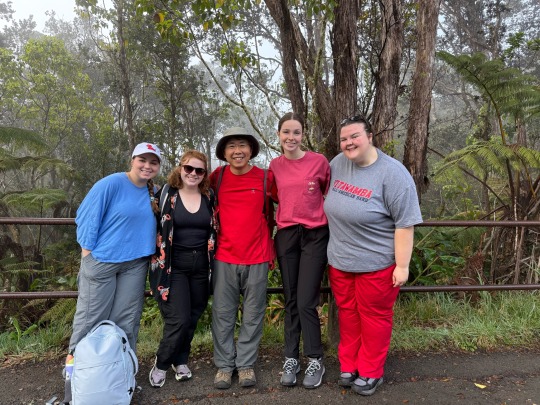
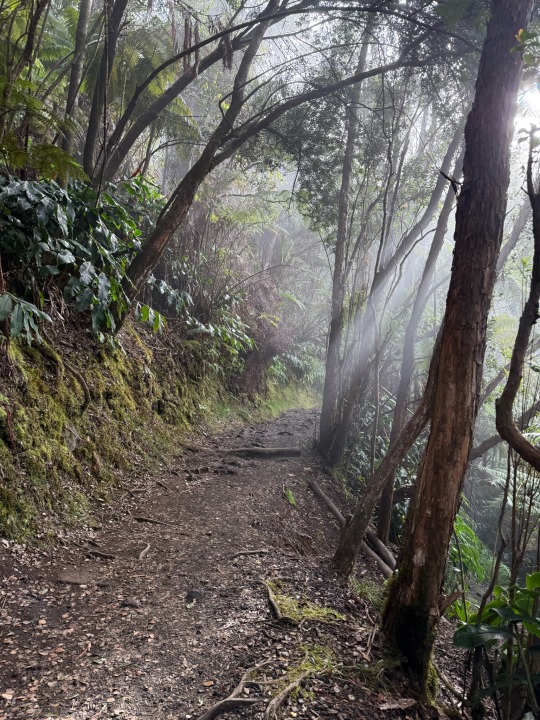
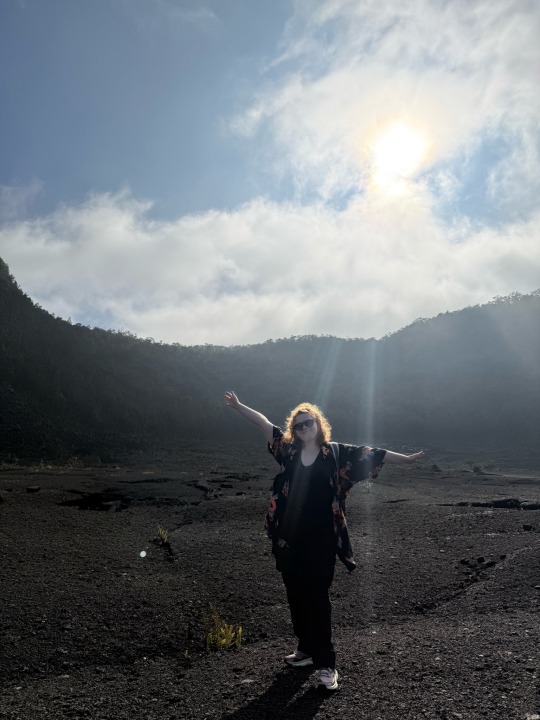
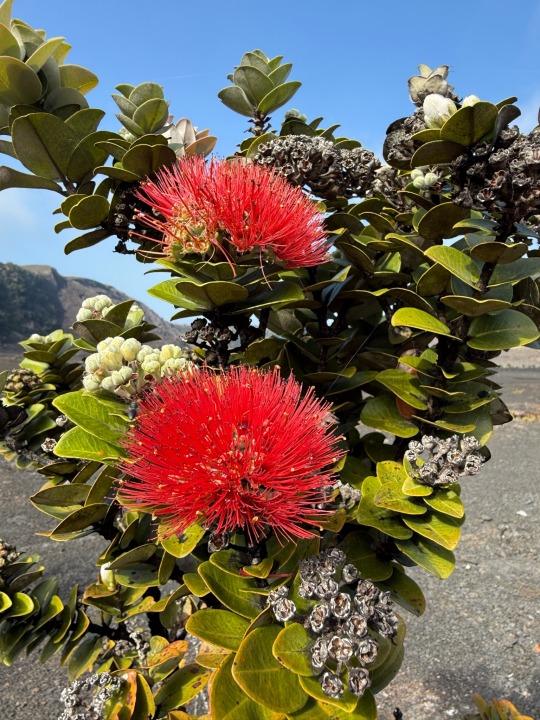
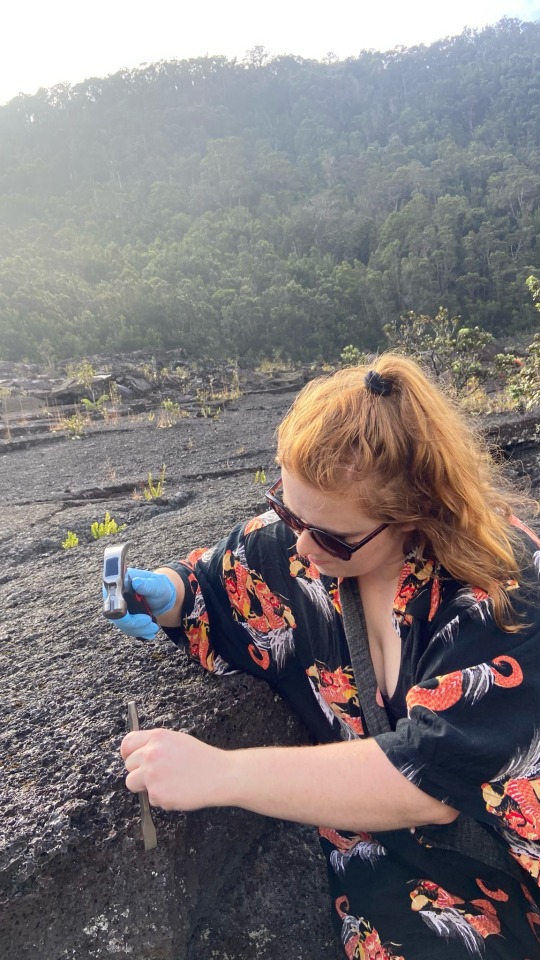
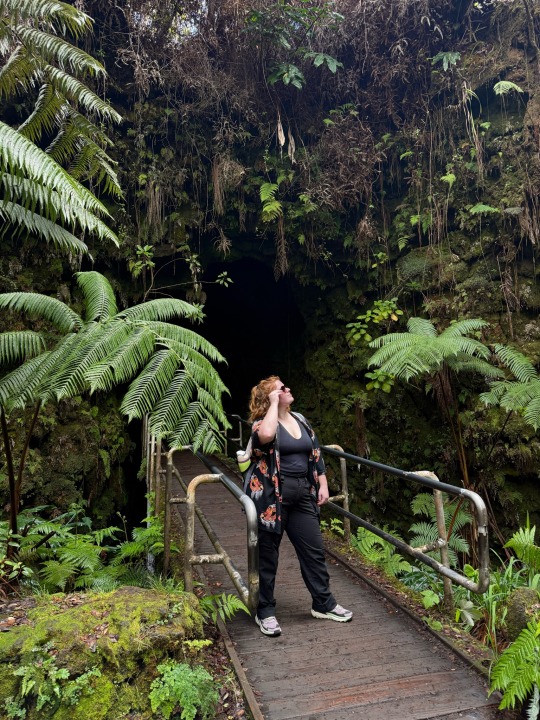
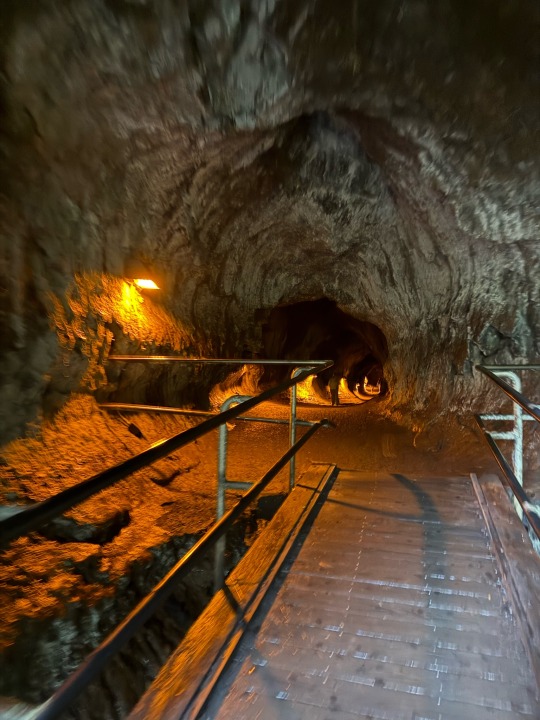
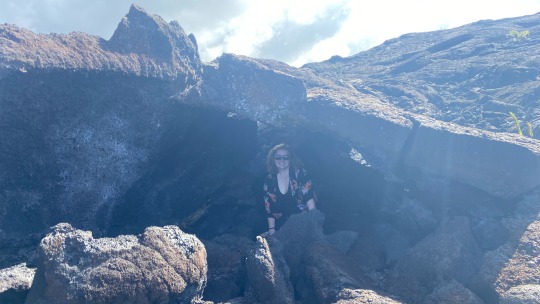
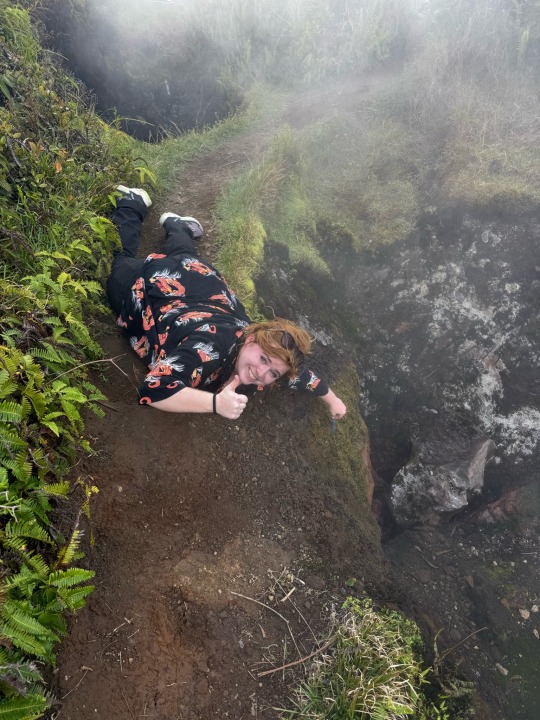
0 notes
Text
Day 2 (Jan 5th)
Another bright and early wake up, this time we went to a farmers market nearby to scavenge some breakfast and coffee. We were immediately greeted by the scent of delicious local coffee that made me wish I liked coffee. While the group did that, I peeled off to explore by myself. I found everything from local art to fresh produce and my favorite find- local baked goods. I collected a varied array of sweets, savory, and one of the best cups of cider I’ve ever had. I parked myself on a bench to people watch and enjoy my fritatta, pumpkin cream cheese muffin, and lava muffin. I even found a brief trail that I wished I had time to further explore.
Then it was back to the tea farm. I personally really enjoyed the sensory walk, giving me an opportunity to decompress and really enjoy the sights and sounds and smells without worrying about seeming non attentive to what was being taught at the moment. We were told to think about interlinking systems on our walk, in which I thought about human connections, pollination, and banana mulching leading to lizard habitats. Afterwards was A LOT of participatory systems mapping, and explaining what that was to our Hilo friends. As well as another lunch gathered by Dr. Hom, followed by more mappings, as well as green tea tastings led by Aliya.
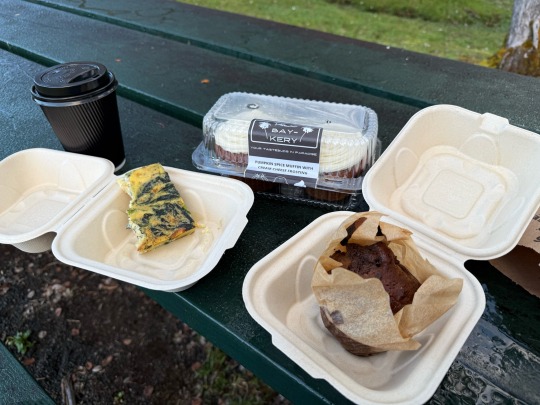
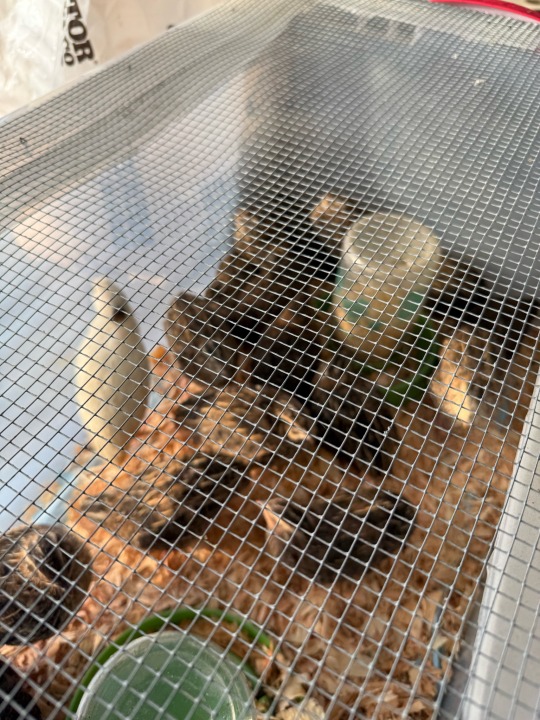
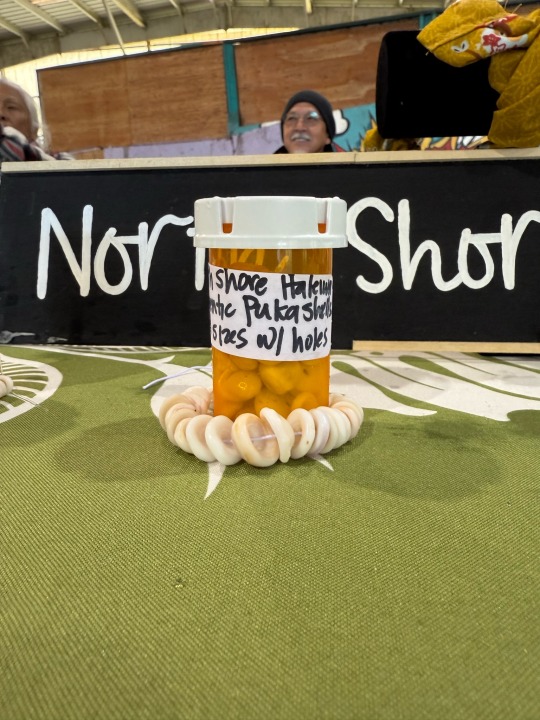
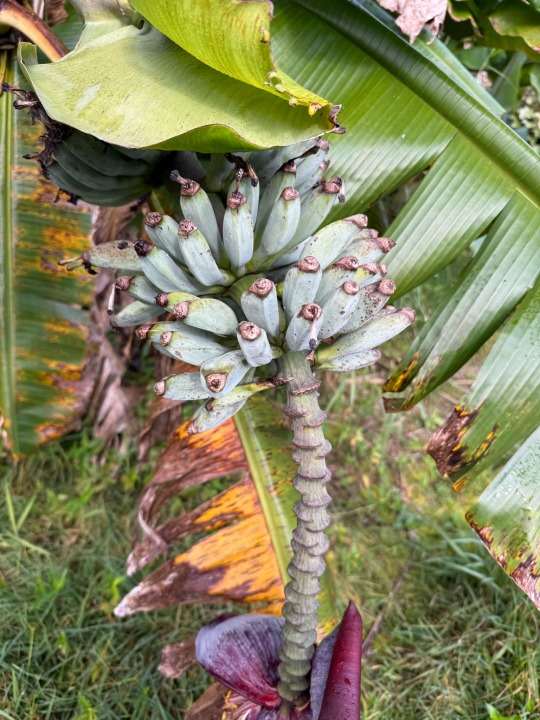
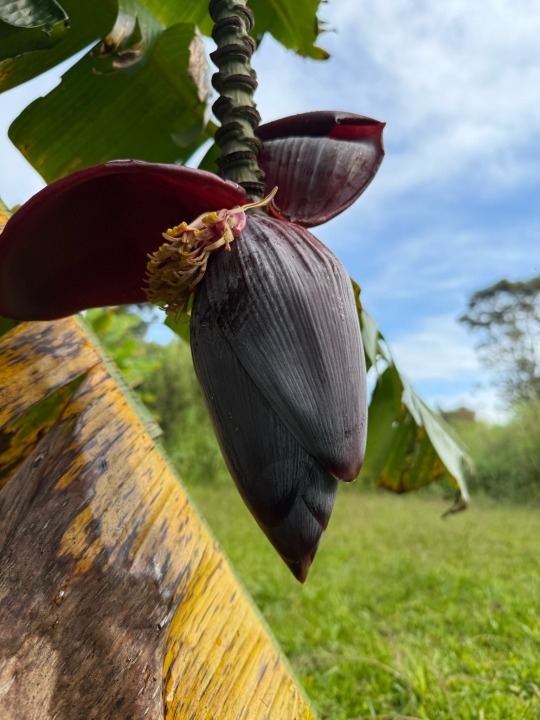
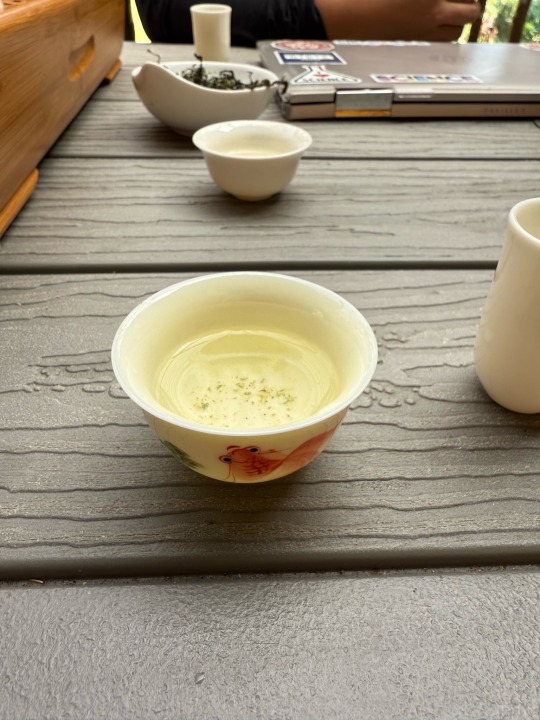
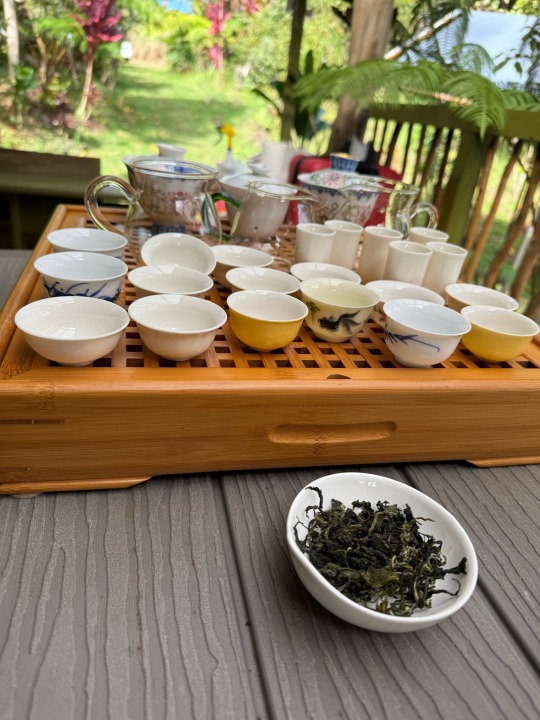
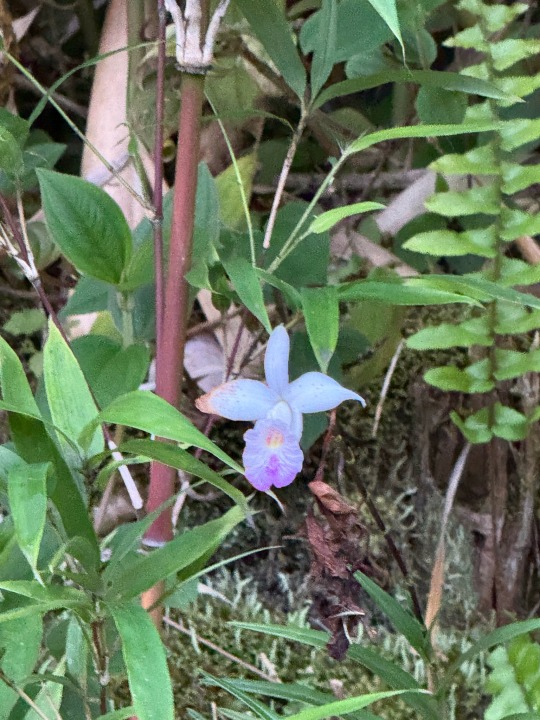
0 notes
Text
Day 1 (Jan 4th)
Today we got to wake up for the first time in Hawaii! Starting off the day in Dr. Hom’s room with our breakfast before packing up and heading to Big Island Tea Farm! After a brief drive, we pulled up and were greeted by some new friends. First Aliya, who started and runs the tea farm with her husband Cam. They’ve been working on this sustainable farm for over 15 years (2001). Then, our new classmates, Lexi and Jocelyn who are from Hawaii, Keelie the environmental science major, and Reena the pharmacy student from Korea. And of course, center of so many of our photos, 3 dogs Polu, Max, old lady, and Miriam the cat. All of us started on our tour with Aliya, starting at the gate and tromping across the more central part of the farm. We saw crops, native species, and invasive species. Aliya explained to us the usage and sustainability factors of each plant she chose varying from shade trees to prohibit grass growth to certain plants to fix nitrogen into the soil. She also explained how this native plants and working with them has beneficially affected her crops, as well as explained their measures to prevent further spread of invasive species.
Next, we started picking tea. Aliya demonstrated how to pick (“a soft snap like breaking an asparagus”) and what to look for (the Pekoe- pronounced Gecko). So, in teams, we set to work, and picked for about an hour and a half, moving over around 30 bushes. Our goal was 1000 grams, but we only managed to get 793g, which Aliya said was a combination of a newness to the activity, the off growing season, and our tiredness. We broke for lunch (Thank you, Dr. Hom, for the yummy poke and eggplant tofu dish) and had a bit of a rest/relax period.
After lunch, it was time to process the tea. In my journal, I documented the process more specifically, but here I will keep it concise to drying, firing, rolling, and more drying. We each got a hand in the process of doing so. Finally, at the end of the day, we packed up and headed back to KMC to clean up and have dinner at Lava Cafe. Good night from HI!
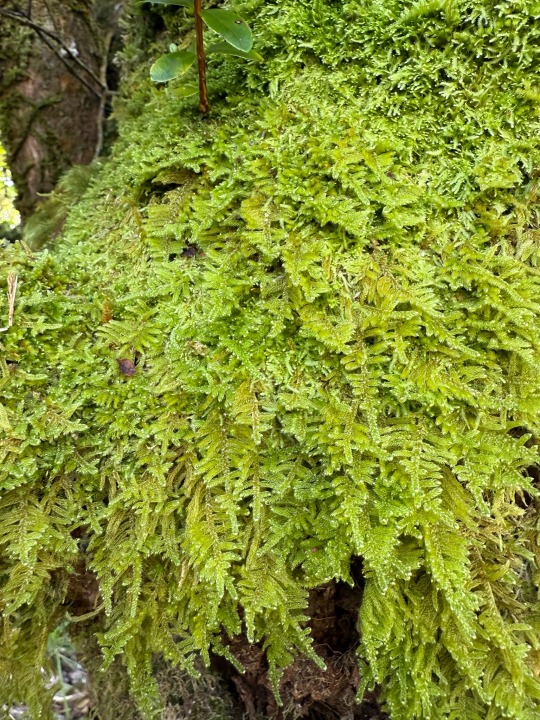
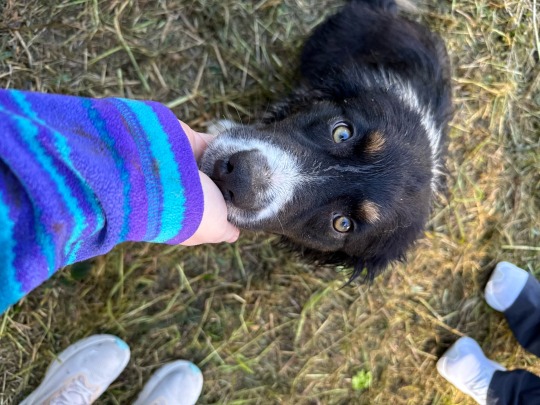
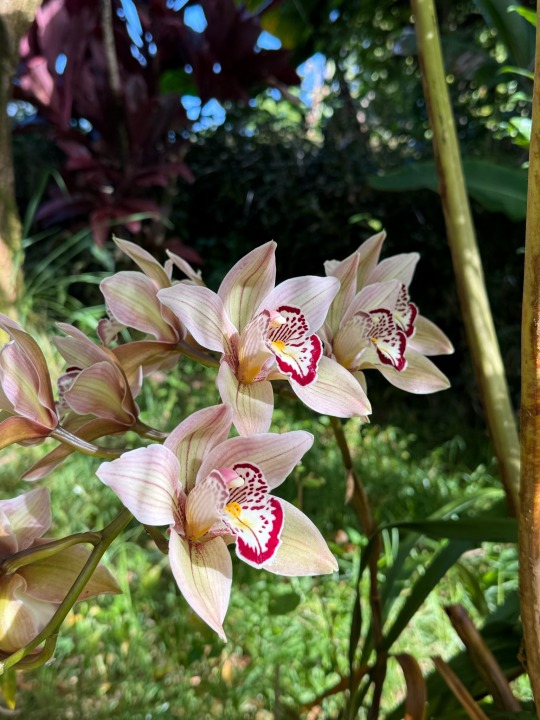
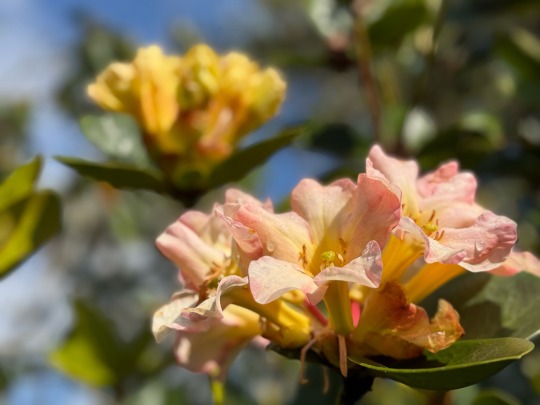
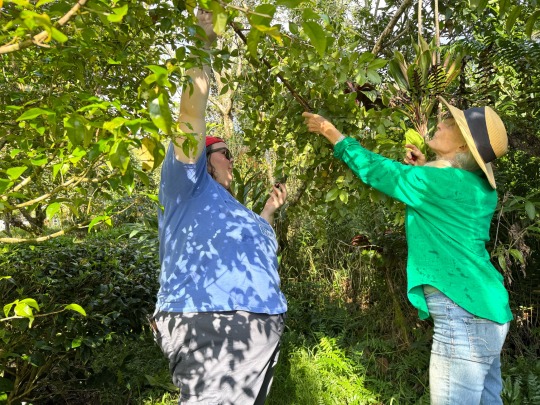
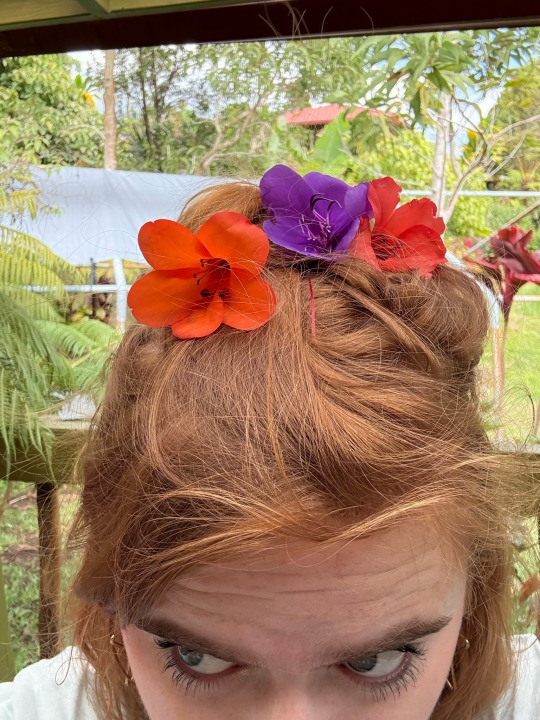
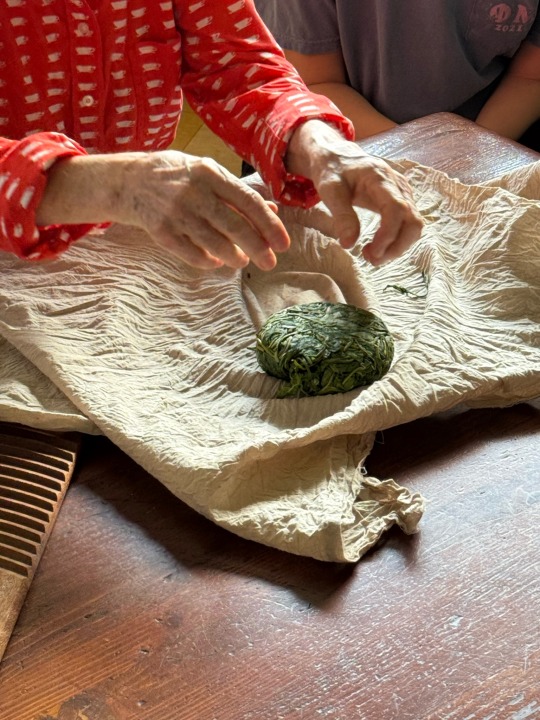
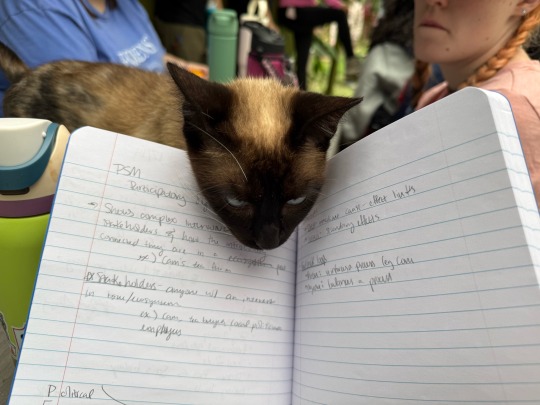
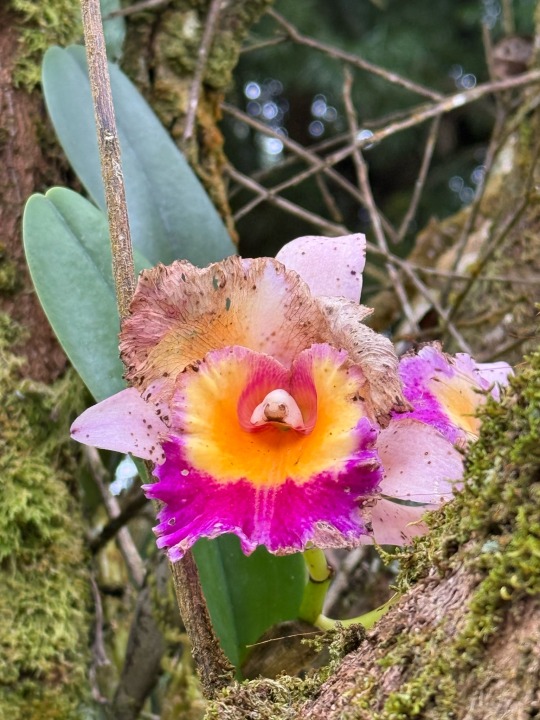
0 notes
Text
Required Reading Reflection
>The Vital Roles of Blue Foods in theGlobal Food System
This 2022 article explains that ‘Blue Foods’ can be defined fish, invertebrates, algae, and aquatic plants captured or cultured in fresh and marine ecosystems. The graphic within the article also assigned some other characteristics such as: siloed in food system polices, threatened by climate change and other stressors, need effective governance, face persistent inequities, demand with double by 2050, support eight hundred million livelihoods, low environmental footprint in many systems, and rich source of nutrients It poses the idea that it plays a primary role in the food security for billions of people, in addition to being cultural and economic cornerstones for many coastal locales. It points out that cultivated blue food source is more economically and ecologically sustainable compared to terrestrial-base food sources. Using this logic, the article draws the hypothesis that putting more emphasis on blue food groups could be a large step in the direction of ending malnutrition and food insecurity with three policy recommendations. First, centralize blue foods in food system decision making. Second, the protection and development of blue foods to end malnutrition. Third, and lastly, supporting the central role of small-scale actors in fisheries and aquaculture.
>Microbes on plantroots change the taste of your tea
This short article discussed how the unique community of microorganism present on tea leaves could change how brewed tea tastes. Yang, from the University of California, Riverside, collected and analyzed tea leaves grown in the Fujian province of China. Their findings showed that specific soil microbes were relate to more nitrogen intake, which in turn boosted the production of theanine in plant roots. Theanine is known to create a rich flavor called Umami, and how much of this flavor is present can affect a tea’s perceived quality. This chemical also has health benefits such as antioxidant richness, anti inflammatory processes, and can counter the effects of caffeine. Next, researchers moved on to extract twenty one of what they considered to be the most influential microbe for theanine production from the soil so they could produce a ‘bespoke’ or optimal microbial community. From that, they applied the creation to the roots of other tea plants which increased the theanine levels, even in plants grown in nitrogen depleted soil. “Increasing the efficiency of nitrogen absorption can also reduce our reliance on fertilizers which could have huge implications for the future of agriculture.” Is a direct quote from Yang, which also shows how this kind of research has a broader impact of a wider variety of agriculture, and not just tea.
>A NOTE ON THE HAWAIIAN LANGUAGE
The Hawaiian language, unlike many indigenous languages in other states, is considered a very alive language, with ‘virtually every resident and visitor to Hawai’i routinely reads and speaks Hawaiian words’. Up until early missionaries brought the latin alphabet to the islands, Hawaiian people did not have a written language. Because of this, some Hawaiian phonetics can be difficult to non-native speakers. Many Hawaiian words are broken up into sections by upside down apostrophes, denoting a natural pause in the work, these breaks are called okinas. Sometimes words can even begin with okinas. Another symbol that denotes emphasis on certain letters is the macron or the bar over the letter.
Hawaii has several common rock types, but most commonly are rocks found around volcanos as the archipelago is a volcanic hot spot. Basalt is exceedingly common. It can be found with green olivine crystals and with black pyroxene crystals, and can have vesicles made by gasses trapped in the lava, which size can denote how fast the lava cooled. Lava is magma that has reached earth’s surface. Hawaiian lava tends to be very fluid, or low viscosity, due to the high temperatures. There are two basic types of lava from basaltic volcanoes. ‘A’ā (pronounced ah-ah) which cools into a jagged, rough surface. And Pāhoehoe (pronounced pa-hoy-hoy) which cools into smooth rounded surfaces. Despite having identical compositions, they have varying viscosities and stiffness.
Erosion is a big problem on the island, caused by wind and water exposure. The rate in which soil forms is largely dependent on climate, which has a lot of variation within the islands of Hawaii. Formation tends to be faster on the windwards sides, and slower on the leeward sides. Weathering is largely caused by rainwater, which when mixed with atmospheric nitrogen and oxygen becomes slightly acidic.
>Participatory System Mapping
Participatory sys
0 notes
Text
Primary Literature Reflection (3)
Nutrient Limitation to Plant Growth during Primary Succession in Hawaii Volcanoes National Park (Vitousek, Walker, Whiteaker, Matson 1993)
One might say that the idea that nutrient limitation might have an effect on the rate of growth and longevity of plant life- especially in areas of primary succession (which is to say, first colonization of organic material post disaster such as Lava deposits). According to Vitosek, Walker, Whiteaker, and Matson in their 1993 paper, it is an idea that “has been discussed more often that it has been determined”, because of the difficulty analyzing the idea in practice. I thought this was a fairly humorous, if not true, way of starting a scientific paper. Nutrient limitation has a simple concept, it is a phenomenon that occurs when the addition of a nutrient has a measurably increased affect on plant growth. While researchers used patterns and ideas from previous similar studies on primary production and nutrient cycling in tropical forests, there largest success and inspiration were from previous fertilization experiments. For this paper, they used a series of factorial fertilization experiments in order to discover the nutrient limitation to plant growth within three tropical montane forests growing in volcanic ash soil located on the island of Hawaii.
For these experiments, researchers chose three sites where the soils were different ages on Kilauea Volcano in Hawaii Volcanoes National Park and evaluated the nutrient limitation on plant growth at each. Starting with the youngest site from a 1959 eruption, this site is denoted the Puu Puai (PP), and at the start of the experiment this site was twenty six years old. This site is located at an elevation of 1120 m, with an annual precipitation level of 2200 m. Researchers noted that in 1985, vegetation was sparse. The next site was the intermediate aged site, dubbed Thurston Lava Tube (TH), at the site of a 1790 lava deposit. This location sat at an elevation of 1190 m with slightly more precipitation than the aforementioned at 2500 m per year. Researchers noted that this site now supports a forest of Metrosideros Polymorpha, or the ‘Ohi’a tree, with an average tree height of fourteen to sixteen meters, with a subcanopy comprised mostly of tree ferns. And lastly, the oldest site, called Ola’a (OL), different from the above because it’s constituted from multiple eruptions from the Kilauea volcano over the course of several thousand years. Though for the purpose of this paper, they consider the thickest deposit to be around 2000 years old. Ola’a sits at an elevation of 1220 meters with an average of ~2900 annual precipitation. While researchers admit these sites do not create a “perfect chronosequence” (or a series of ecological sites that share similar environmental conditions but represent different ages), they believe that the substrate age is the most notable difference within these locations.
For methodology at these sites, researches performed complete factorial fertilization experiments at the two younger sites: Puu Puai (1959) and Thurston (1790). Complete factorial fertilization experiments included testing the limits of Nitrogen, Phosphorus, and T (an abbreviation of all other macro and micro plant nutrients). In the oldest site, Ola’a, they only performed the Nitrogen treatment due to the face that little forest is still intact in that area, and they desired to decrease environmental impact on the area. Each site had different implementations to account for the difference in forest structure along the gradient of soil age. In PP, forty Metrosideros were selected in heights varying from fifty to one hundred cm in height, and “applied each treatment to a randomly selected set of five individuals”. Additionally, fertilizer was distributed to a two meter radius around each of the forty plants. To measure growth, two twigs on each tree were marked, as well as production and mortality of leaves, all of these factors measured and recorded bimonthly. Photosynthesis was also measured using a portable LICOR 600 system. At TH, researchers set up a grid system of forty ‘20x20 m’ sections, fertilizer was applied to the interior (15x15) of four of these plots, with dendrometer bands to applied to measure diameter increments of trees bimonthly. Litter traps wrecks also placed at random and litter fall was monitored monthly. Lastly, at OL, researchers chose twelve individual Mestrosideros, and out of the twelve, six were chosen for treatment of only the Nitrogen, and banded to monitor diameter growth. This area also had litter traps. To measure these findings, researchers would assess nutrients in soil samples and foliar nutrient samples from Metrosideros and Cibotium. In addition to soil cores, canopy leaves were collected in each plot, and dried in an oven at seventy degrees celsius, ground up, and analyzed for nitrogen and phosphorus.
The results, showing the reports of the second year to decrease the bias or effect of lags or transient effects that might have occurred at random in the wild. These results showed that at the PP site, when Nitrogen was added there was a notable increase in diameter grown in Metrosideros as well was height growth. Similarly, at the TH site, nitrogen addition the soil increased total plant growth. However, Phosphorus addition saw no increase in growth, but did see an increase in foliar production. In the OL site, the oldest, there was no noticeable effect of added nitrogen to the soil.
From the methodology and results provided, Researchers determined that the element of nitrogen, and the limits of, is a primary factor in plant growth in young mountainous tropical forests. They used this research to determine what kinds of amendments to soil nutrition has the most effect on primary succession, and it appeared to be Nitrogen, as it had the most effect on diameter growth. It also seemed to have more effect the younger the site, as it slowed progressively between the sites to the least significant in the OL site. Phosphorus added to the soil added more extractable phosphorus from plant tissue but didn’t seem to have a measurable effect on plant growth especially in the younger sites. Researchers note that these finding are consistent to a similar experiment done in 1976.
0 notes
Text
Primary Literature Reflections (2)
Comparative Bacterial Diversity in recent Hawaiian Volcanic deposits of Different Ages (Vicente Gomez-Alvarez, Gary M. King, & Klaus Nüsslein, 2007)
In this 2007 paper, Gomex-Alvarez, King, and Nüsslein set out with specific objectives to achieve their goal of understanding the evolution of bacterial diversity in volcanic environments as time passes and succession continues. The objectives were as follows, “expand our knowledge of microbial community composition in recent volcanic deposits and to determine the extent to which community structure varied spatially within the Kilauea caldera, to identify environmental factors that correlate with structure, and to assess the extent to which patterns observed for trace gas uptake and contribution were reflected in the composition of microbial communities as a whole.” (Pg. 61) As the most isolated collection of islands, an archipelago, on the planet, combined with the areas proclivity for volcanic activity. The study was orchestrated to learn about bacterial diversity between three young volcanic deposits and an established young forest (approximately three hundred years), to do this they would “compare 16S rRNA gene libraries based on strategic progression of statistical methods.” To do this, they used KVD (Kilauea Volcanic Deposits) 1959, 1921, and 1700, which would be forty-one, seventy-nine, and three hundred years old respectively.
This study took place in Volcanoes National Park in the state of Hawaii, using the active Kilauea volcano. This volcano takes up has an area of 1430 square miles, which is 13.7% of the total island. Lava deposits have an absence of organic matter and a limited amount of nitrogen which severely limits colonization and bacterial activity. Additionally, since solidified lave is non-permeable, it struggles to retain water cotent. The KVD had ranging water content (14.0%-82.5%) as well as a range in pH levels (3.9-5.7). There was a lot of flux observed in the statistical analyses showed distinct levels of CO and H₂ in the 1700 KVD and 1921 KVD, but no significant flux in the 1790 or 1959 KVD. Researchers used ‘triplicate samples’, or triangular patterns, where each corner is located 10-20 m apart, collected on the same day at the same place so that DNA could be isolated and then amplified through a PCR program in a PTC-200 Peltier Thermal Cycler. From these trials, it was difficult to observe the presence or absence of diversity in the species found in the triplicate samples. So researchers “relied on the use of species richness and nonparametric approaches to compare the diversity of differs sites” (pg. 63). Using the Simpson’s Index, since it’s even often used in other microbial and ecological studies for it’s discriminating abilities, and also the Shannon-Wiener, higher reciprocal index values indicated communities with greater diversity and distributions of species. Next, several different software’s were used to determine factors like potential bacterial species richness, rarefaction curves, total genetic variation, nucleotide diversity, and homologous and heterologous converse curves. Finally, statistical analysis was used to determine the “significance of differences in the soil properties, trace gas uptake rates, and contribution among four volcanic deposits… analyzed using linear regression.” (pg 64)
Using all of the above methods, researchers divided results into four categories: PCR amplification of 16S rRNA gene and richness, DNA sequencing and phylogenetic analysis, community diversity, and community diversity, gas flux, and soil parameters. First, using the purified total DNA, the results of the PCR amplification of 16S rRNA gene and richness showed 1500 bp detected from all volcanic deposit samples, in which coverage from the Clone library ranged from sixty - six to eighty - three percent of estimated richness. While researchers admitted that more sampling would be required to get complete and total coverage, the rarefaction curves did not level off, indicating that more samples would have shown more samples- except for the 1921-KVD rarefaction curve that did begin to level off, suggesting that the primary bacterial groups had likely already been identified. Secondly, with in the DNA sequencing and Phylogenetic analysis, researchers found indications of the presence of ‘Acidobacteria, Alphaproteobacteria, Betaproteobacteria, Cyanobacteria, Gammaproteobacteria, Planctomycetacia, and Thermoomicrobia’ (pg. 64). All of this was listed out in Table 1, organized by bacteria name and and site the samples were gathered from. For example, it listed out Acidobacteria abundance levels as 9.0% at the 1959 KVD, 1.2% at the 1921 KVD, 11.2% at the 1790 KVD, and 2.5% at the 1700 KVD. 56% of all sequences had no specific bacterial phylum assigned by the RDP II, and therefore were unclassified. While the 1959 KVD, 1921 KVD, and 1790 KVD libraries were primarily composed of these ‘unclassified’ bacterial phylums. However, in the forest site, the 1700 KVD, the dominated at 78% by the Alphaproteobacteria, with 6% of the phylums being unclassified. At the 1790 KVD site, the identified sequences belonged to 11% Acidobacteria, 8% Cyanobacteria, and 5% Actinobacteria. The 1921 KVD site showed identified sequences of 6% Planctomycetacia, 6% Actinobacteria, 1% Acidobacteria, and 1% Gammaproteobacteria. And lastly, at the 1959 KVD site, which was the youngest site sampled, it’s samples showed 14% Alphaproteobacteria, 10% cyanobacteria, 9% acidobacteria, and 6% Gammaproteobacteria. Third, the community diversity results showed that the highest rate of diversity calculated within the 1790 KVD site, with 1959 KVD coming in second, and then the oldest despite (1700 KVD), and lastly the 1921 KVD. Between the oldest and the youngest deposit sites, 1700 and 1959 respectively, there was only one shared phylotype that was distinguished. However, between the 1959 KVD and the 1790 KVD, ten unique phylotypes were found in common, which was 38% of their populations. Fourth and finally, the results in community diversity, gas flux, and soil parameters, which results also showed closer similarity between 1959 and 1790 KVDs, with strongest correlations in the differences of carbon, nitrogen, and water content.
From this methodology and the results it yield, points to the conclusion that time is a key factor in the environmental succession after lava has been deposited. Fresh lava deposits aren’t suitable for much else but microorganisms, as their is a notable absence of organic matter and a lack of nitrogen make it hard for organic material to thrive. Bacteria is some of the first organisms that can survive in this environment, and overtime these bacterial communities can evolve from tolerant species to diverse groups that begin nutrient cycling. The longer these bacteria are left, the more conditions are improved for other organisms to habitats the area, leading to the 300 year old 1700 KVD becoming a fertile, forested area.
0 notes